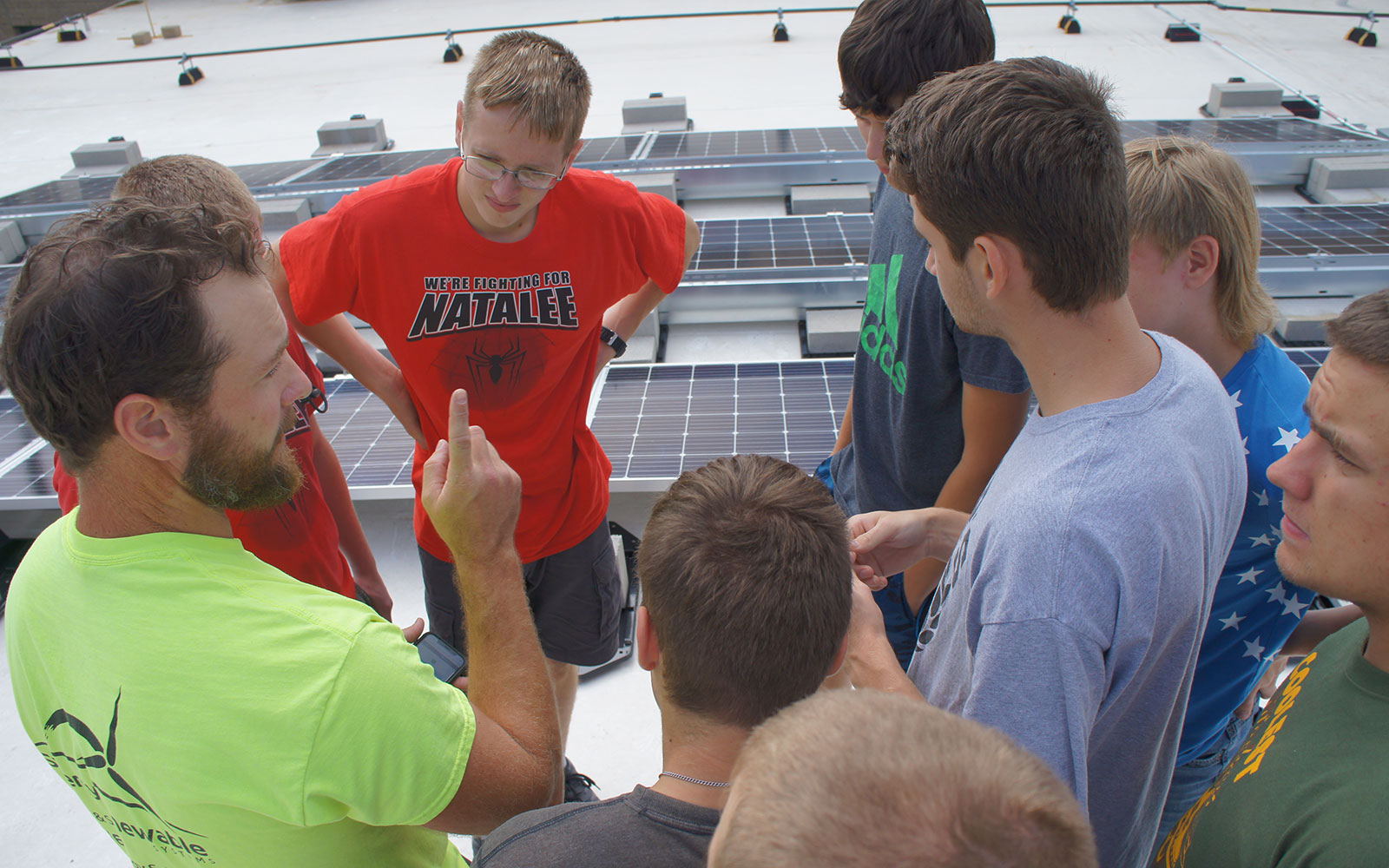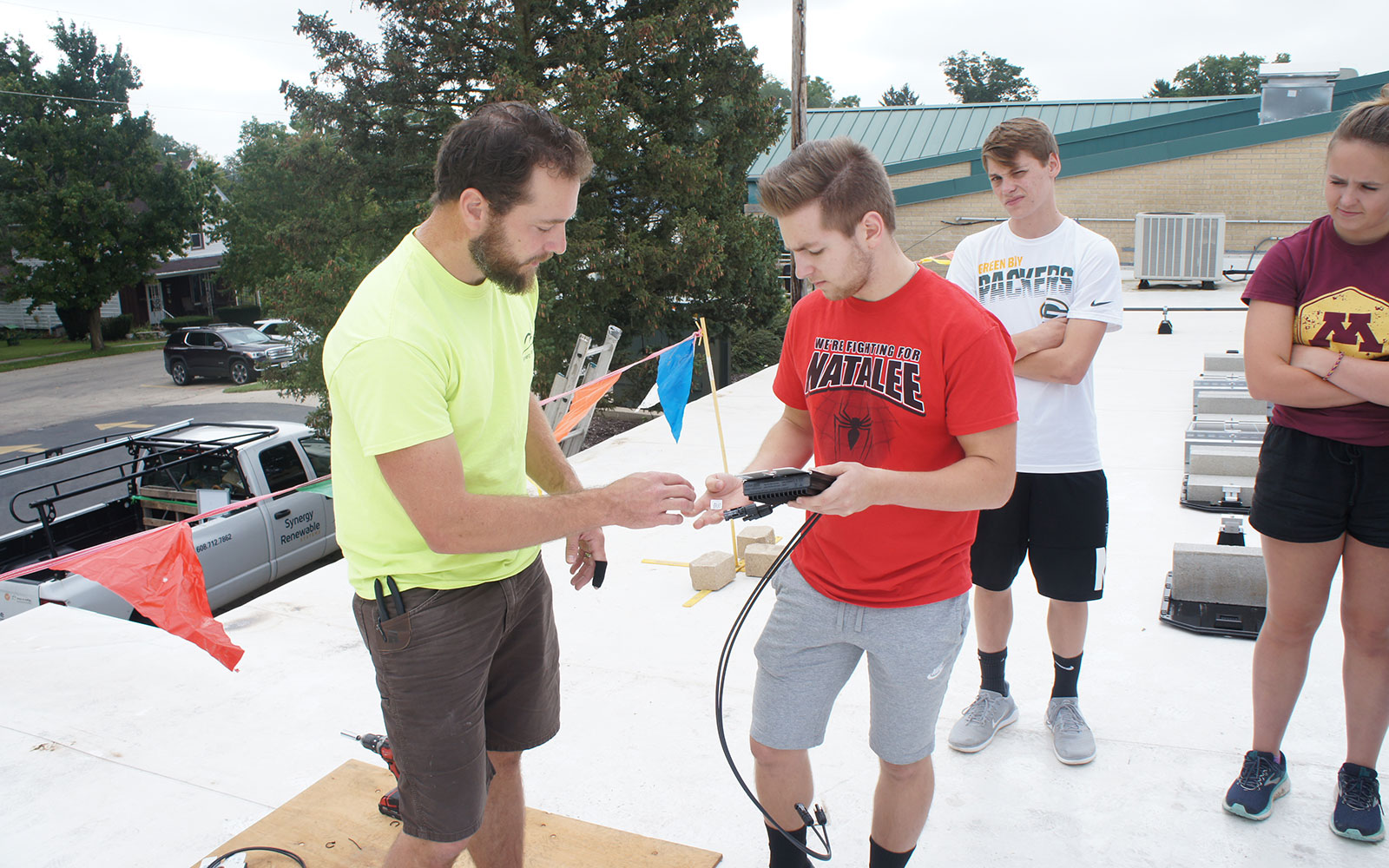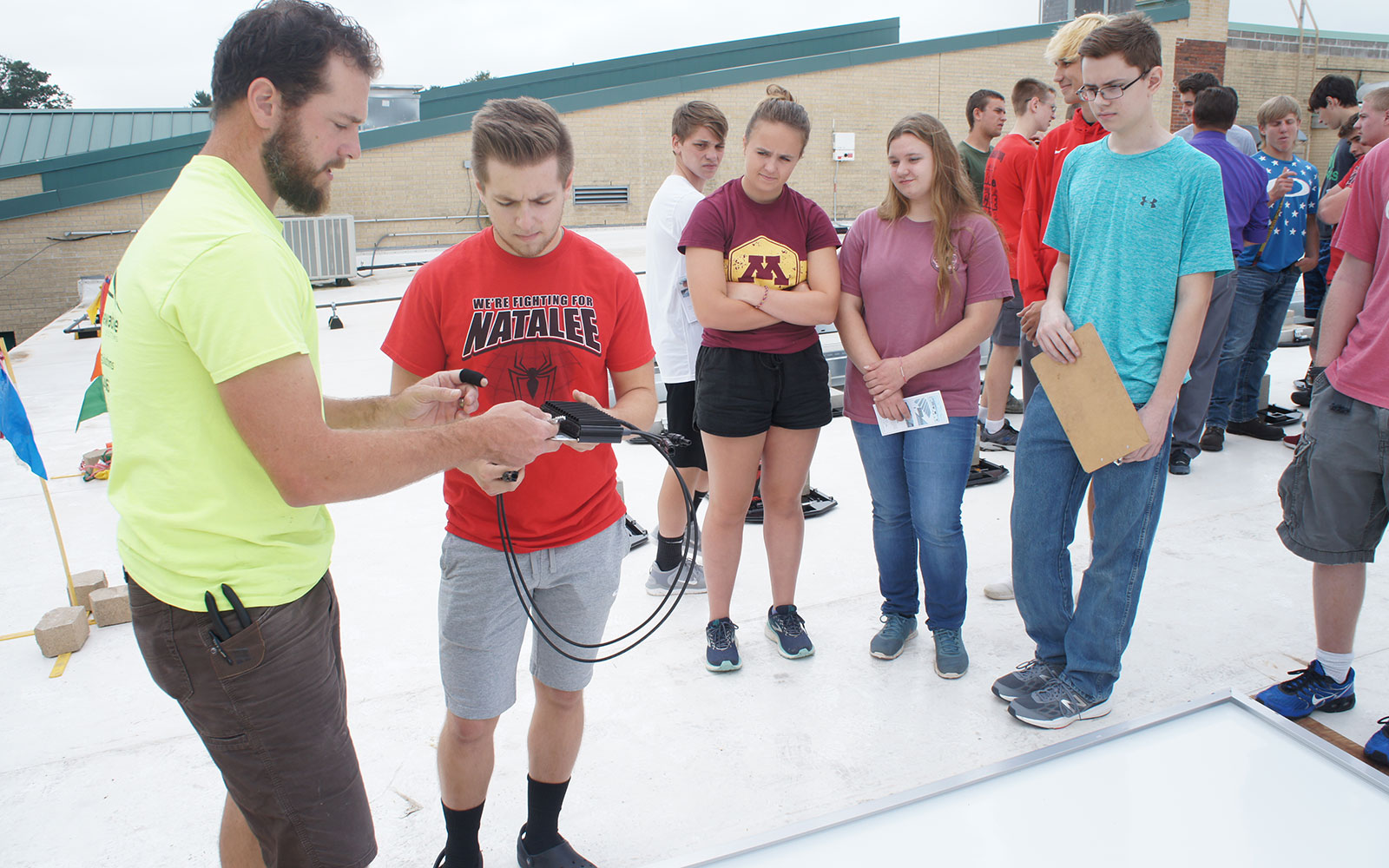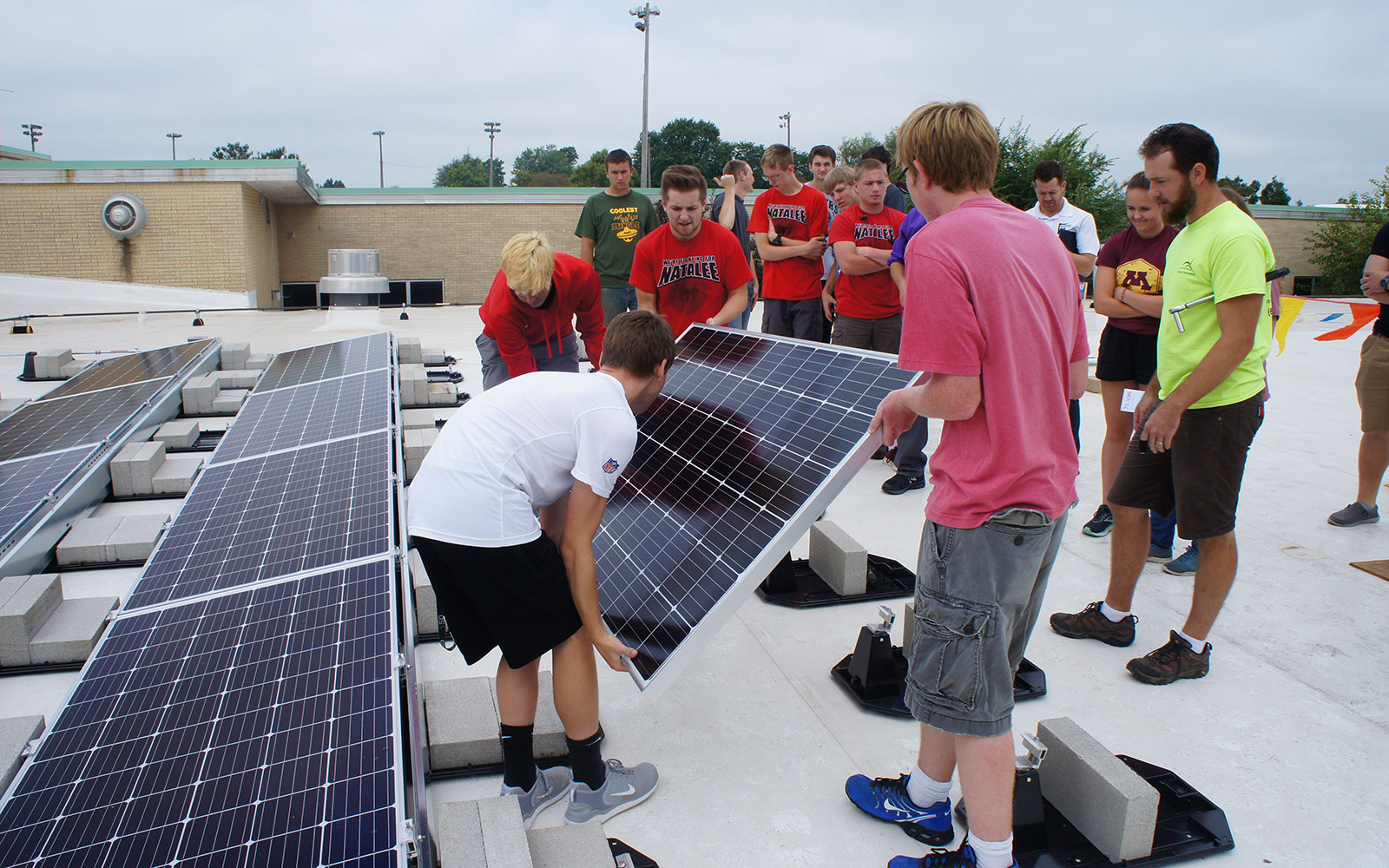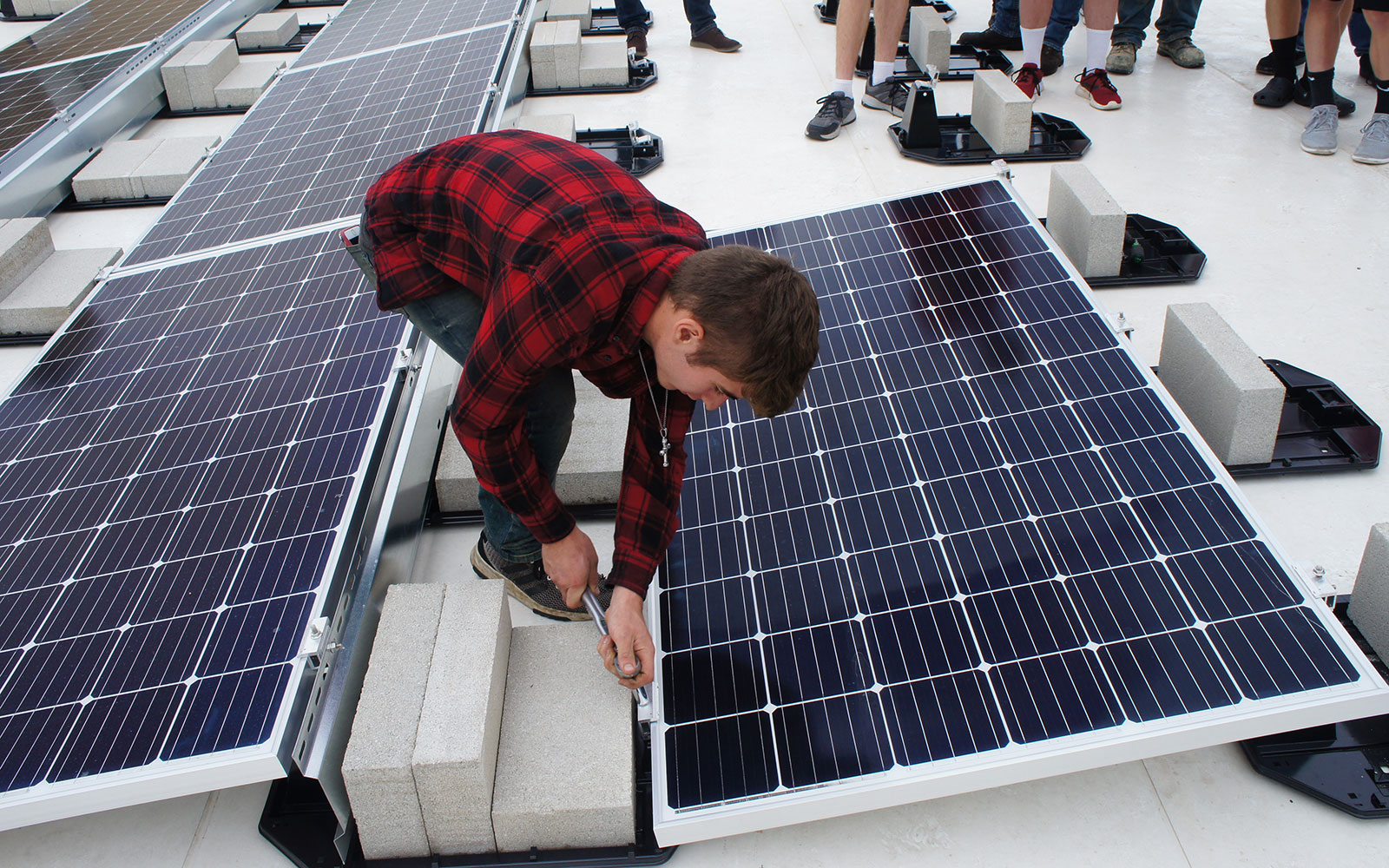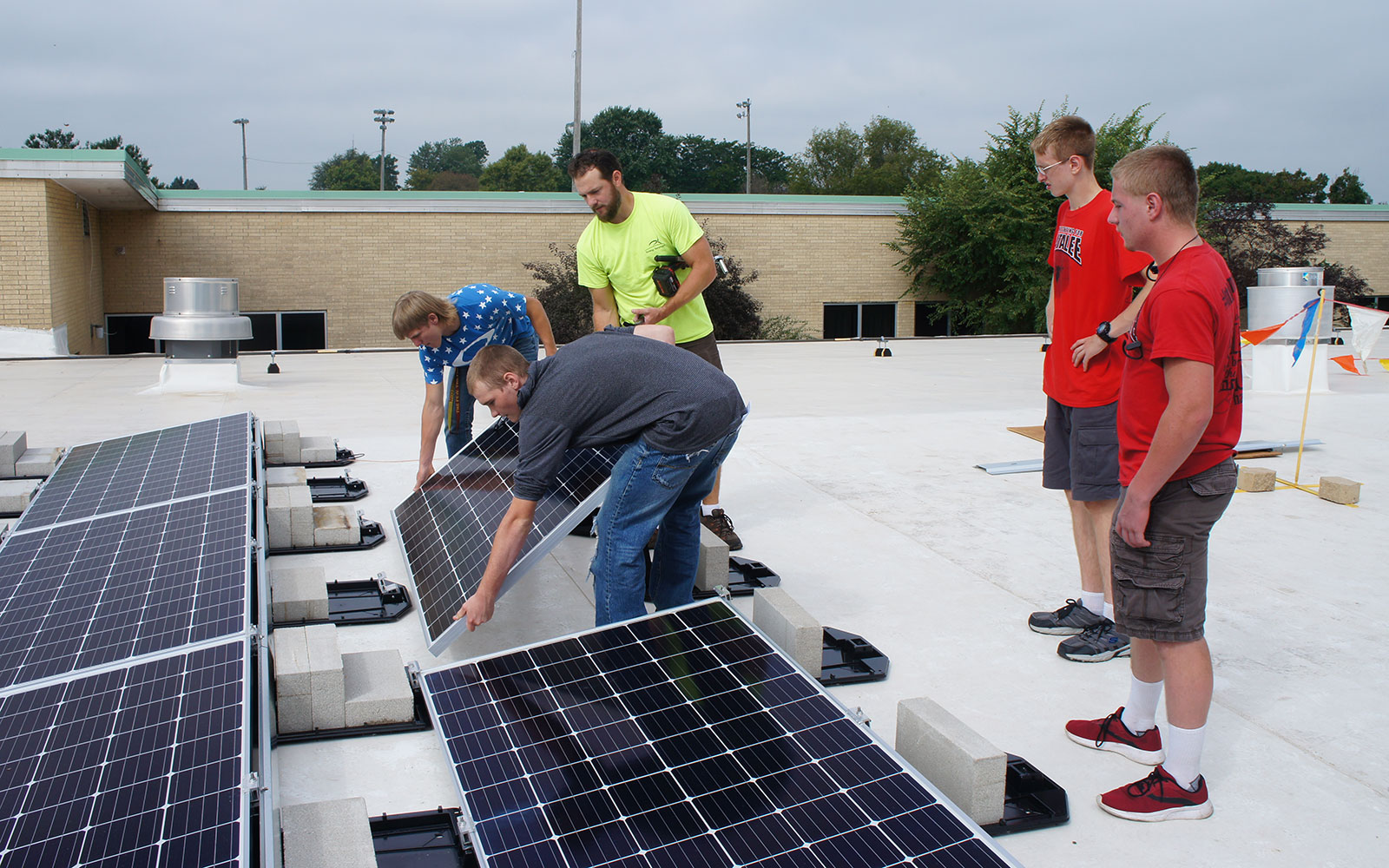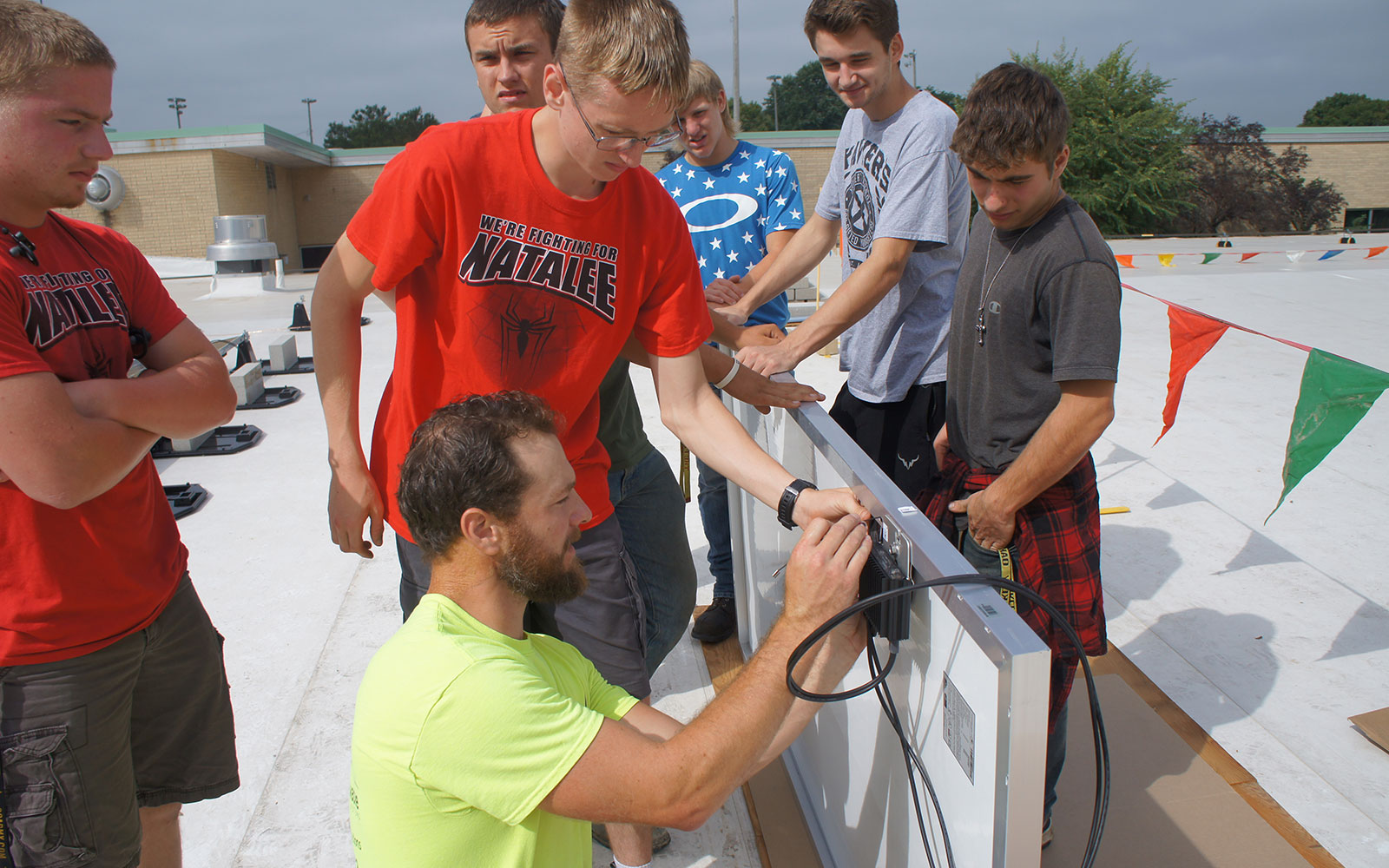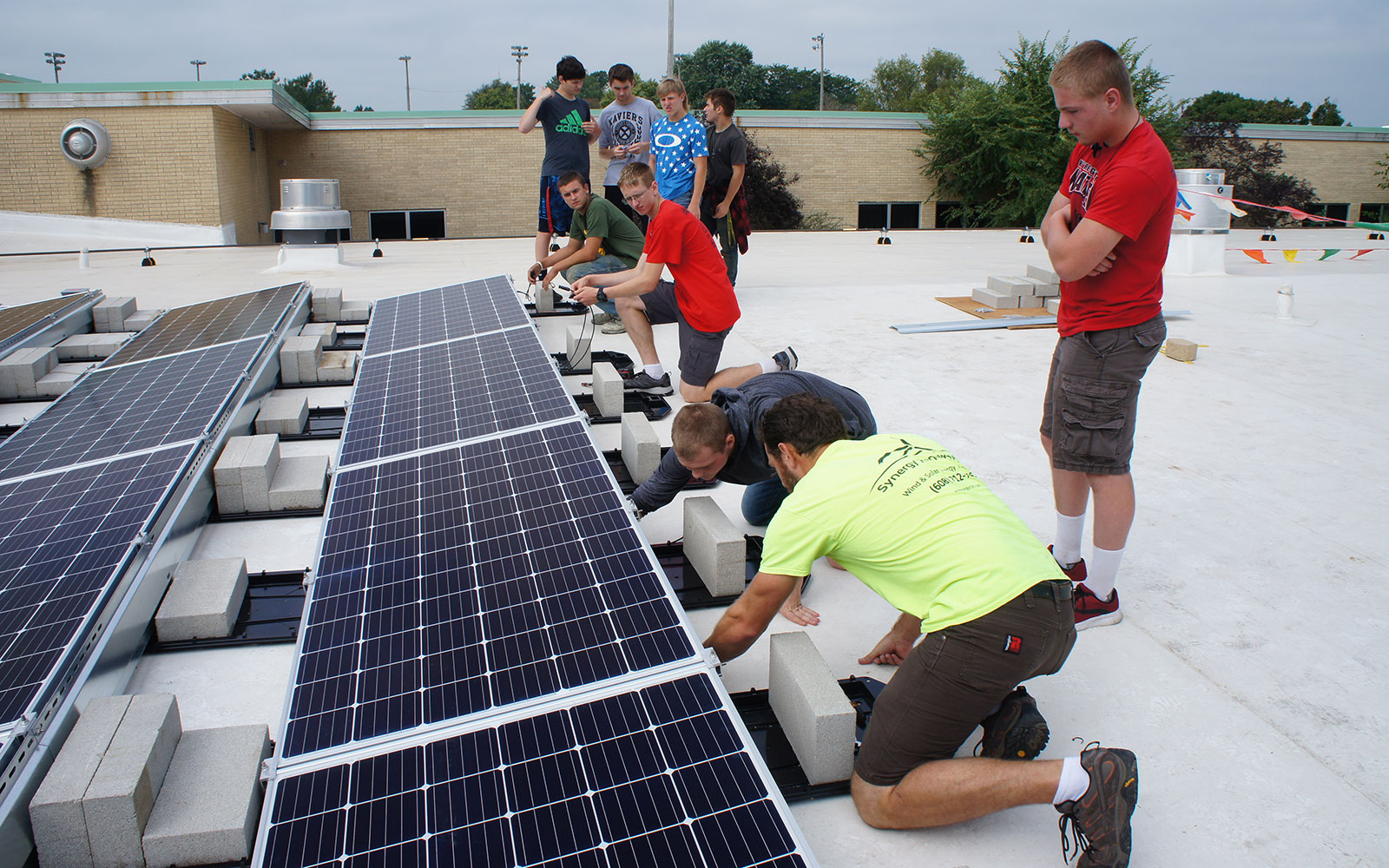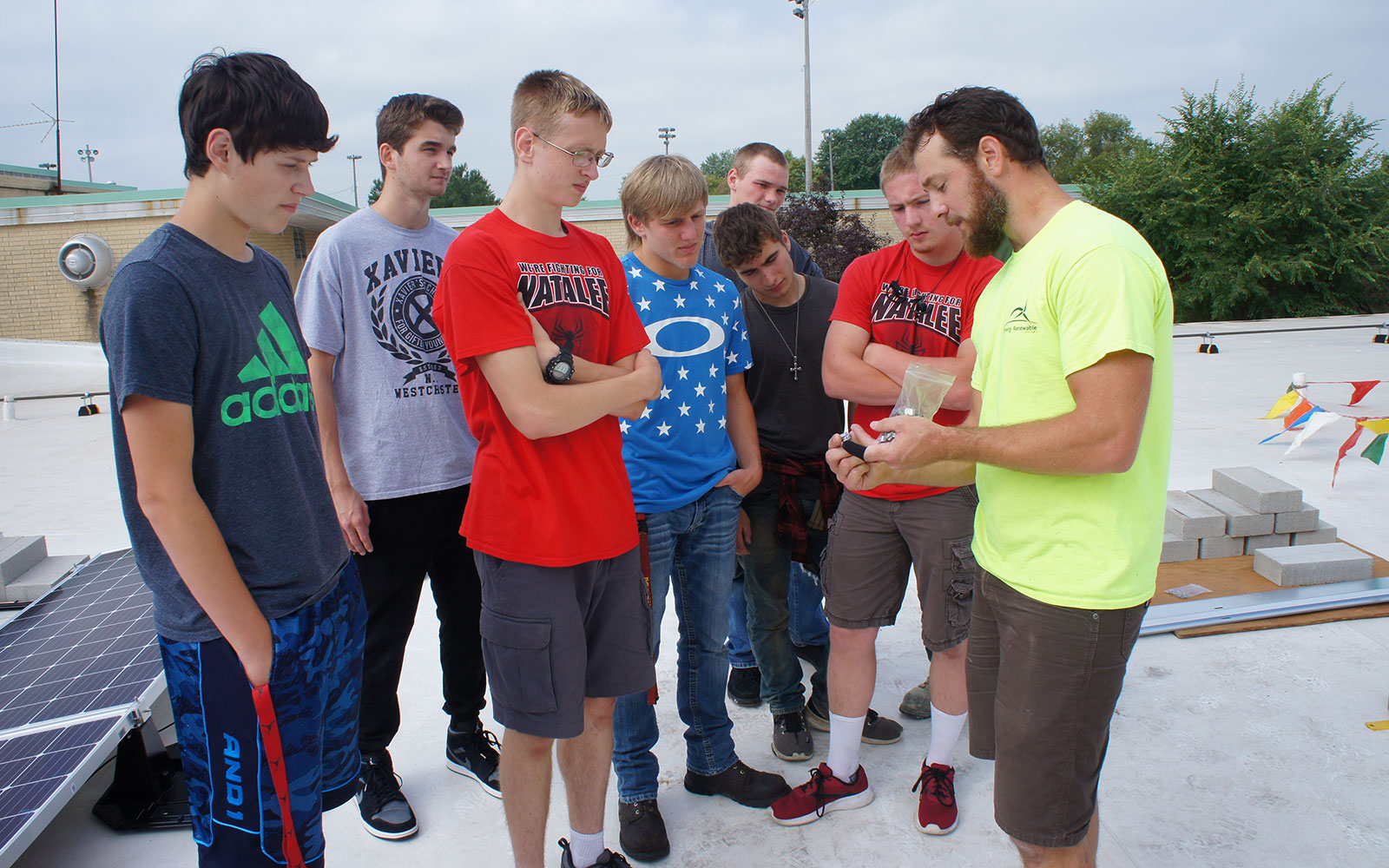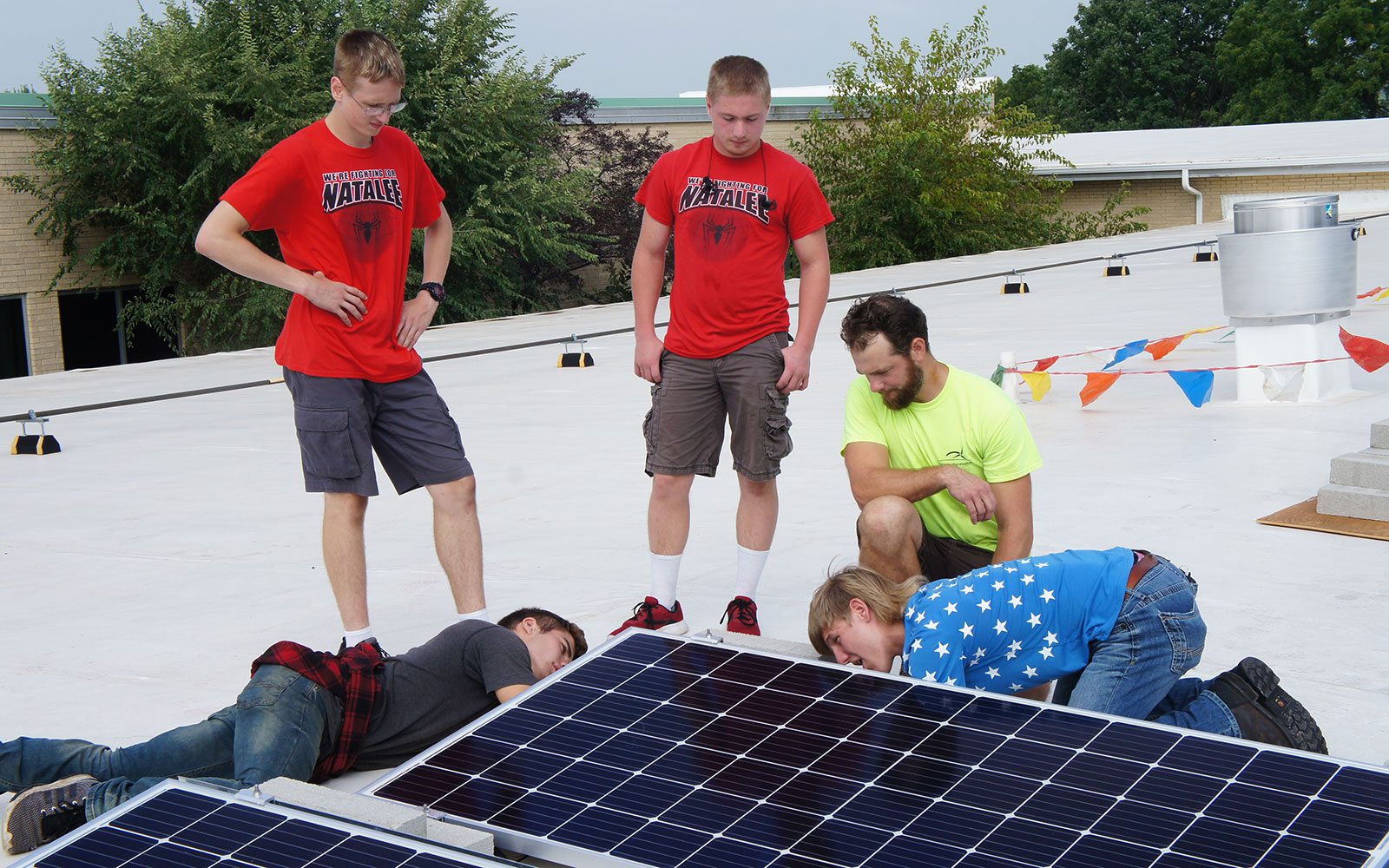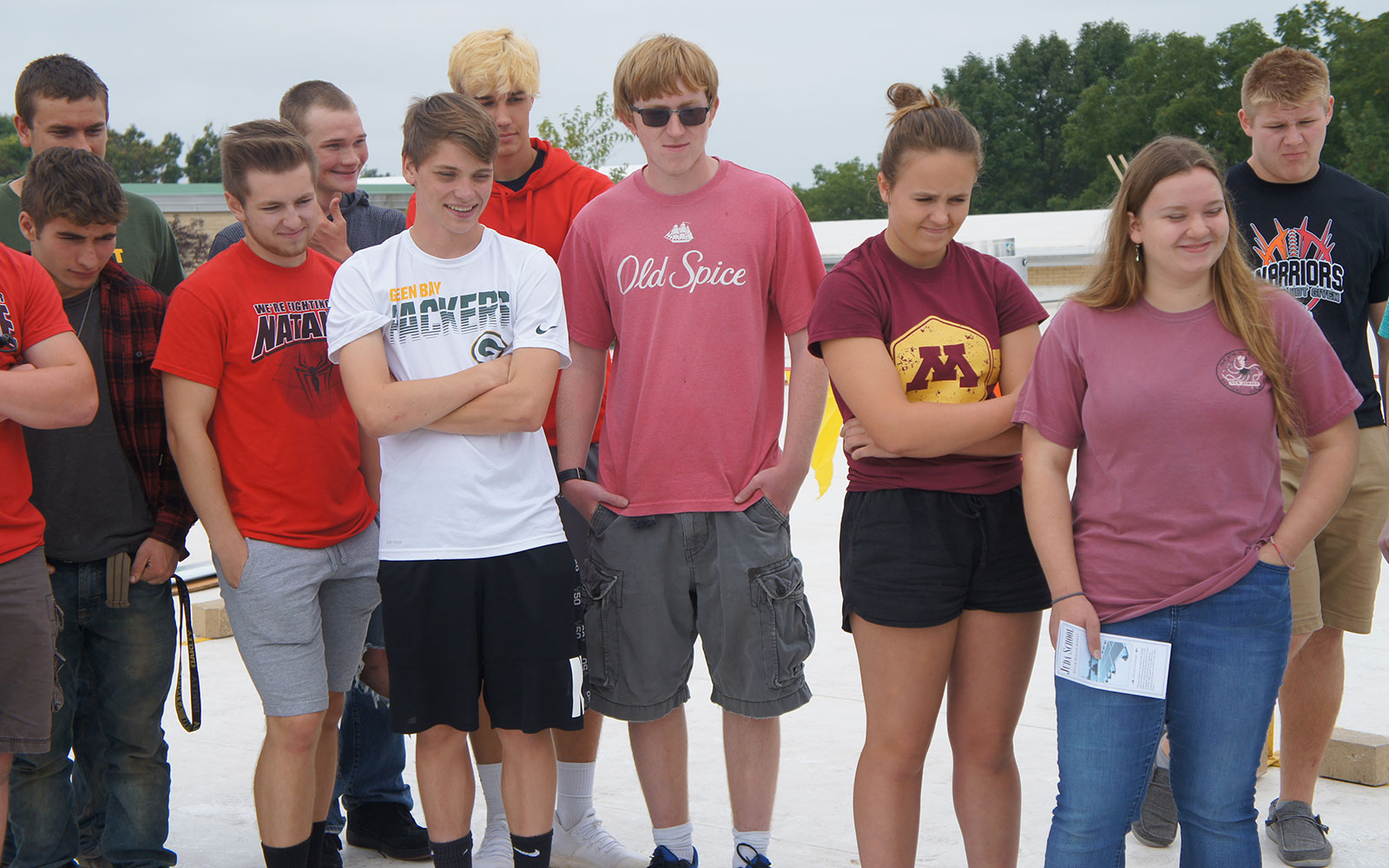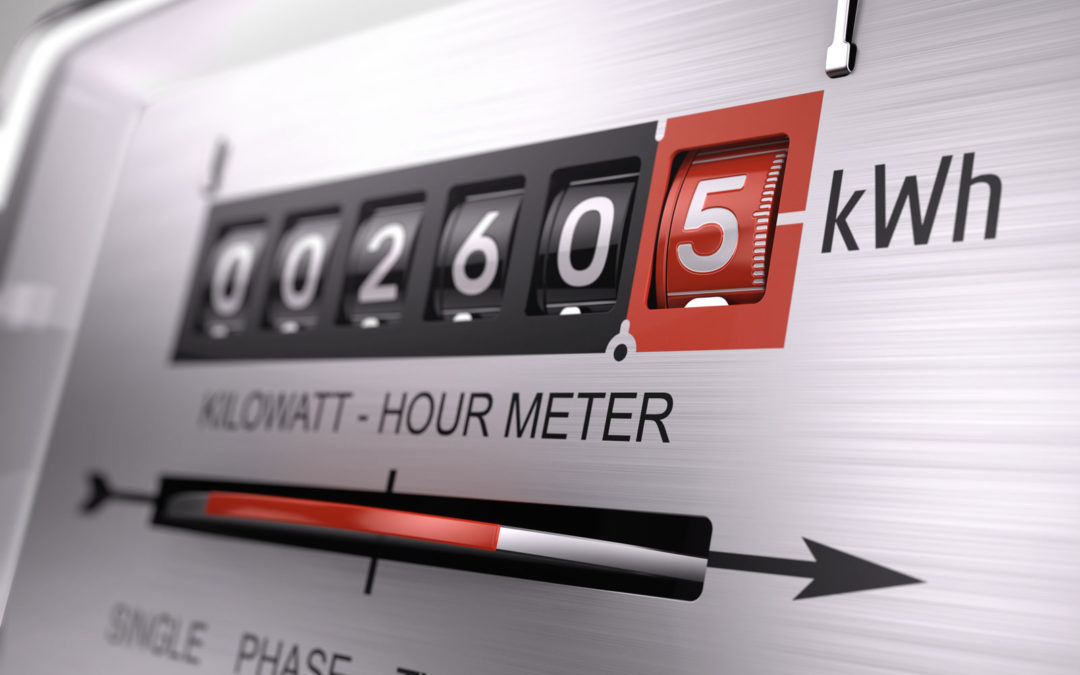
by Tyler Huebner | Jan 7, 2020 | Renewables, Solar, Utilities
Our goal is to streamline the process for renewable energy installations and utility reviews.
Over the past two years, RENEW Wisconsin has been actively working as a member of the Wisconsin Distributed Resources Collaborative (WIDRC) to modernize and improve the necessary forms for applying to install a new distributed generation (DG) system in Wisconsin.
We are excited to help spread the word that as of January 1, 2020, the new forms are available and recommended for use!
These forms represent one of the first formal steps in the process of getting approval to install a new distributed generation system in Wisconsin. Distributed generation systems include solar electric (photovoltaic), small wind, battery energy storage, biogas or biomass electric generators, and/or other technologies that fall under Wisconsin Administrative Code Chapter PSC 119.
Access the New Wisconsin DG Application Forms
Distributed generation installers must complete these forms and submit them to their local electric provider to start the process of obtaining the ability to “interconnect” with the local electricity grid.
You can download the new forms here. See the right-hand column “New Wisconsin Interconnection Forms” for the links to each form.
These DG application forms replace the 6027 and 6028 forms and consolidate the information needed into one “base” form, the Wisconsin Standard Distributed Generation Application Form. Then, installers will fill out a more streamlined technology-specific form to provide the information on which type of distributed generation system(s) will be installed.
The forms are fillable in PDF and can be digitally saved to speed up the process. In addition, the forms now clarify that each size category for DG systems is based on AC electricity ratings.
Installers should continue to use the same 6029 (20 kilowatts and under) and 6030 (above 20 kilowatts) Interconnection Agreement forms when the system is ready to be interconnected to the utility.
Reducing Solar “Soft Costs”
Improving these forms is one of many activities we are undertaking to reduce the “soft costs” of installing solar and DG systems in Wisconsin. In particular for solar, where approximately 1,000 systems are now being installed annually in Wisconsin, we’re looking to save time in the permitting, inspection, and interconnection processes. Time saved in each of those processes will add up quickly when installers are doing it one thousand times each year!
To make this happen, Jodi Jean Amble, our Communications & Events Director, spent a lot of hours designing and constructing these new forms to be very user-friendly. We are hopeful these forms will make the DG application process a little bit easier for our members and all the companies that need to use them.
To learn more about this process and update, please check out this letter that was provided to Wisconsin electric utilities and DG installation firms.
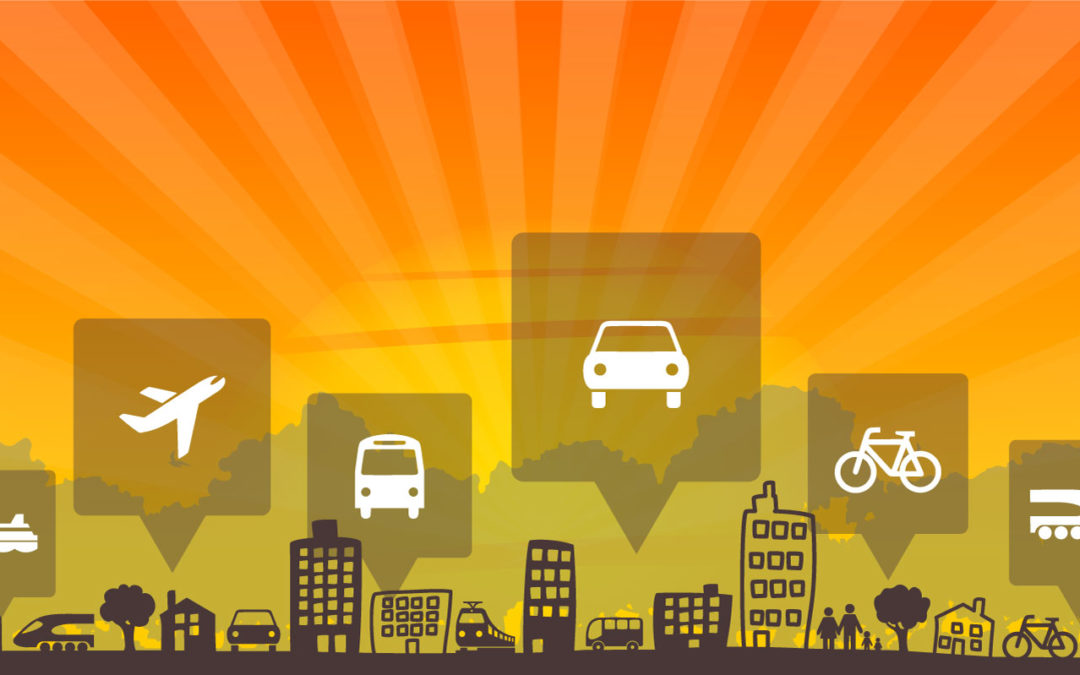
by Jane McCurry | Dec 31, 2019 | Electric Vehicles, Sustainability
In the very first edition of the RENEW Wisconsin Electric Vehicles Blog, I shared my transportation story. That was over a year ago, and now we are approaching a new decade, which will be sure to bring just as much change as the last. Here’s a quick rundown of what I see as the biggest transportation changes over the past 10 years, what’s coming next, and how I plan to clean up my own transportation use in 2020.
10 years of transportation
In 2010, 3 days after my 16th birthday I got my driver’s license, kickstarting my experience with personal transportation.
In 2015, I purchased a red (Go Badgers!) 2010 Ford Escape. I didn’t even think about buying an electric car. Sometimes, I opted to drive my car because it was warm and easy, despite having the option to reduce my emissions by walking, taking the bus, driving my moped, or biking.
Then, in July of 2018, I started working at RENEW. I was immersed in clean energy – and quickly realized that my transportation choices didn’t align with my values.
I spent a year learning as much as I could, evaluating my lifestyle, and crunching the numbers on an EV purchase. I bought a Tesla Model 3 and moved to an apartment with solar on the roof. My husband and I are an all-electric, one car household. I call a rideshare when I need it – and in Madison, I can call an all-electric rideshare with Green Cab.
This is not the transportation future I imagined when I started my transportation story in 2010. I have more options, and produce fewer emissions, than I could have imagined 10 years ago. Madison is a walkable city that has an all-electric cab company, BCycle electric bikeshares, beautiful bike paths, and an extensive bus system that is being renovated and electrified. I can (and do!) take advantage of these options to live my clean energy values more fully.
A clean energy resolution
As I reflected on my personal transportation choices this decade, I decided to make Clean Energy Resolutions for 2020:
- Buy carbon offsets for my air travel.
- Try not to rideshare alone. I will bus when possible and call a Green Cab when I need to, reducing my solo rideshare trips (it’s not really “sharing” when I’m the only one in the car that needs to go there).
How has your personal transportation evolved over the decade? What would your Clean Energy Resolutions be?
Here are a few options to dip your toe into a clean energy transition this year:
- Pledge to take the bus once a week in January
- Instead of a “swear jar” have a “lights jar” at home – anyone caught leaving a light on when they’re not in the room owes the jar $1
- Take part in National Bike to Work Day this May, bonus points if you get coworkers involved
- Look into your utility’s green power program, or other ways to offset your home’s electricity use, like solar
- Test drive an electric car (I bet you’ll like it!)
- Become a RENEW Sustaining Member
- Get a solar site assessment – at home or your work – to see if solar is right for you. See our list of trusted installers here
What will next decade hold?
This decade saw a lot of change in the way people get around. Rideshares like Uber and Lyft became common, electric scooters took over sidewalks nationwide, and electric vehicle sales tipped over 1 million in the U.S.
I expect that next decade it will be even easier to get around with enhanced micromobility options, cleaner buses with more bus routes, and more electric vehicle models than ever. These transitions are happening nationwide and Wisconsin is no exception. In addition to Madison, La Crosse, Milwaukee, and Racine all have electric buses ordered. Madison is working toward bus rapid transit, which will make commuting faster, cleaner, and more equitable for thousands of Wisconsinites. Micromobility is happening everywhere too – the founder of Bird Rides, one of the big scooter-sharing companies, grew up in Appleton! And, there are bikeshares in cities as small as Wisconsin Rapids and as large as Milwaukee. Together, these options will make it easier to get where you need to go, with fewer emissions.
For passenger vehicles, expect 200 different EV models to be available by 2025, giving us more size, shape, price, and brand options in the electric vehicle market. To add to it, I am really excited to see how the transition to autonomous vehicles will play out, especially as we transition to electric and shared mobility at the same time.
Buckle up, it’ll be a fun ride!
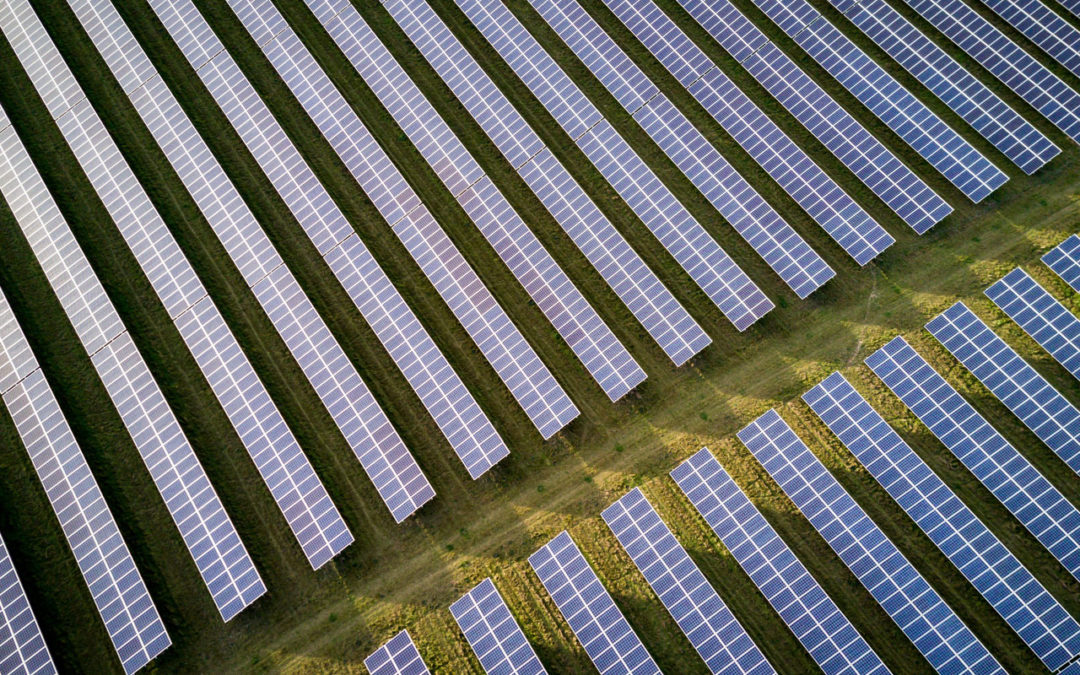
by Tyler Huebner | Dec 19, 2019 | Public Service Commission, Renewables, Solar, Utilities, Utility Scale
Today, the Public Service Commission of Wisconsin approved the Point Beach Solar Farm project!
Point Beach will be a 100 megawatt solar farm, and will supply electricity to WPPI Energy. WPPI is a wholesale energy provider for 41 municipal utilities in Wisconsin plus 10 more across Michigan and Iowa. The developer is NextEra Energy Resources, one of RENEW Wisconsin’s newest Business Members.
Almost three years ago, WPPI Energy made a splash by announcing the results of a request for renewable power proposals. At the time, wind energy was expected to be the winner of that competition. But this solar farm proposal was selected, foreshadowing how cost-effective solar power was becoming in Wisconsin.
Since then, other major power suppliers have followed WPPI Energy’s lead. In April 2019, the PSC approved the Badger Hollow and Two Creeks Solar Farms. Along with the 49.9 megawatt Richland County Solar Farms which was approved at the County level, these projects marked the first utility-scale solar approvals in Wisconsin.
This Point Beach Solar Farm will be placed on ground right around the existing Point Beach Nuclear Energy plant. It will also be located next to the Two Creeks Solar Farm now in construction, with the two projects combining to provide 249 megawatts of solar capacity in Manitowoc County.
With today’s PSC approval in hand, construction will begin next year and it should come online in 2021. It is expected to provide enough energy to serve more than 23,000 people.
Congratulations to NextEra Energy Resources and WPPI Energy on this project approval!
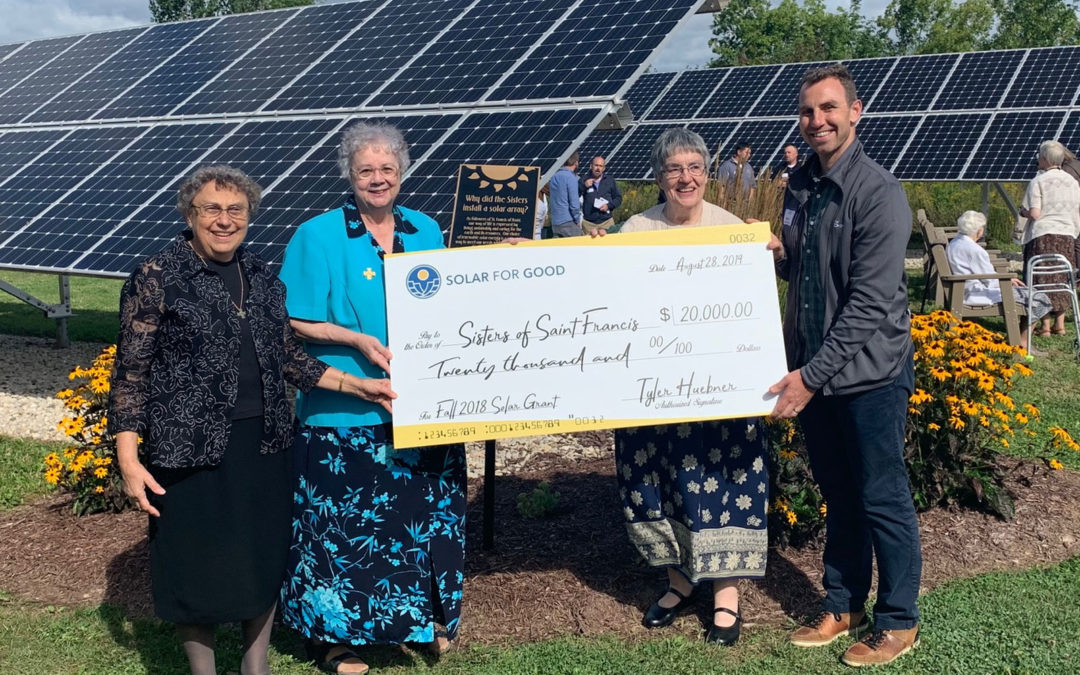
by Sam Dunaiski | Dec 16, 2019 | Community, Local Initiatives, Programs, RENEW Wisconsin, Solar, Solar for Good
RENEW Wisconsin’s Solar for Good program will issue nearly $140,000 worth of solar panels to Wisconsin nonprofits as part of their fall 2019 funding cycle. These grants will go to 13 organizations across the state that together will install nearly 600 kilowatts of clean, renewable electricity. When completed, these solar projects will lead to over $1.2 million of solar investment in Wisconsin.
The following organizations have been offered Solar for Good grants to install new solar electric systems:
CAP Services, poverty alleviation, Stevens Point
Camp Amnicon, outdoor retreat and spiritual worship, South Range
Menīkānaehkem, Native American educational organization, Gresham
Habitat for Humanity – La Crosse Area, affordable housing provider, La Crosse
Jackson County Animal Shelter, safe haven for stray animals, Black River Falls
Heartland Housing, affordable housing provider, Madison
First Unitarian Society of Milwaukee, house of worship, Milwaukee
Boys & Girls Club of Greater La Crosse, youth education, La Crosse
Bethel Lutheran Church, house of worship, Madison
Movin’ Out, alternative housing provider, Madison
Zwingli United Church of Christ, house of worship, Verona
Kathy’s House, alternative housing provider, Wauwatosa
One organization has asked to remain anonymous at this time.
This round of Solar for Good funding features a diverse group of awardees from across Wisconsin. The Boys and Girls Club of Greater La Crosse will use their solar installation to help educate members on renewable electricity and energy efficiency for their recently-renovated facility. Over 200 solar panels will be installed at Kathy’s House, a hospital guest-house in Wauwatosa. And the Indigenous-led organization Menīkānaehkem, will install solar to power several tiny homes being constructed on the Menominee Indian Reservation to house the community’s homeless population.
“We decided to go solar to reduce our energy bills and to focus more of our resources on programming,” said Guy Reiter of Menīkānaehkem. “We plan to use the array as a training center for community members interested in pursuing a career in solar. Thanks to the Solar for Good grant, we are moving closer to our goal of making the Menominee community energy-sovereign as a way to create jobs, restore hope, reduce carbon pollution, and mitigate climate change.”
This marks Solar for Good’s 5th funding cycle and the second-largest to date. Including the fall 2019 funding cycle, the program’s impact will total 74 Wisconsin nonprofits installing 88 new solar arrays throughout the state. The program will add 3.25 megawatts of clean, renewable power to Wisconsin’s electric mix, enough to power approximately 650 homes. In total, these 88 solar arrays will spur over $7 million in investments in renewable electricity.
About Solar for Good
RENEW Wisconsin’s Solar for Good initiative fosters the expansion of solar power among mission-based nonprofits and houses of worship in Wisconsin. Through a generous partnership with Couillard Solar Foundation, RENEW Wisconsin awards solar panels to nonprofit organizations, helping them switch to clean, renewable, solar energy.
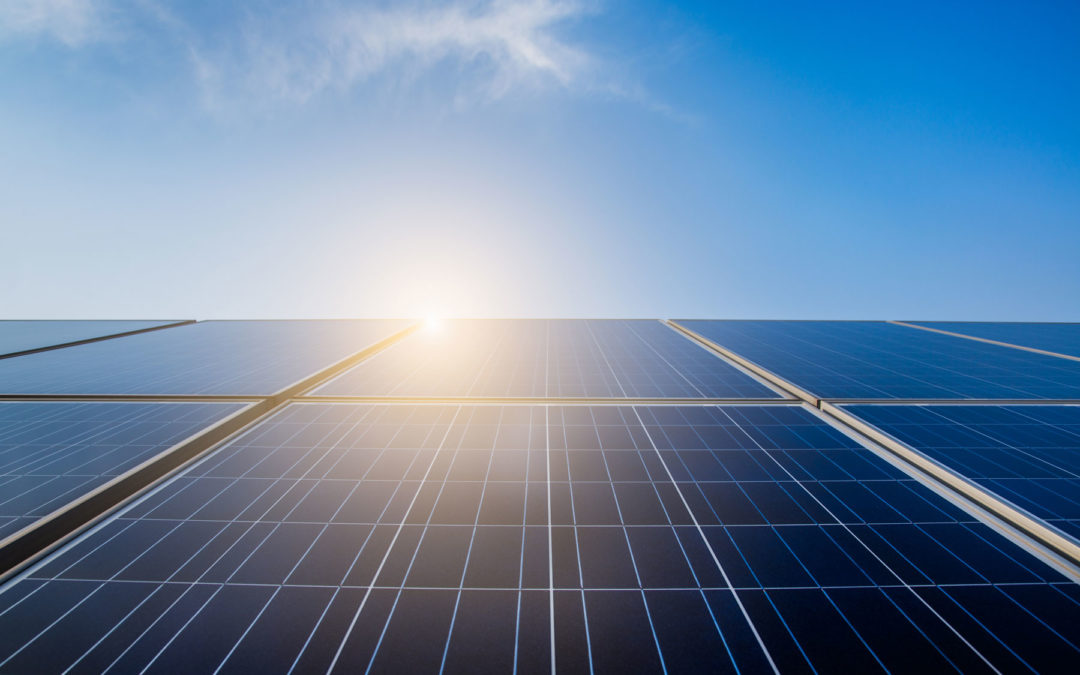
by Tyler Huebner | Dec 3, 2019 | RENEW Wisconsin
RENEW Wisconsin has partnered with Madison Community Foundation (MCF) to offer a charitable gift annuity.
What is a charitable gift annuity?
Like other annuities, a charitable gift annuity offers a regular stream of income on an initial investment until your death. However, charitable gift annuities are a form of planned giving and therefore differ from other annuities in several ways.
Here is how the charitable gift annuity works:
- You make a donation to a nonprofit organization, such as RENEW Wisconsin, and take a partial tax deduction.
- MCF, as the holder of the annuity funds, invests the funds on behalf of RENEW Wisconsin and pays you (the annuitant) a regular payment until your death. A portion of this income also may be tax exempt.
- After your death, the balance of the invested funds go to the nonprofit organization (RENEW Wisconsin, in this case).
The amount of your tax deduction depends on a number of factors, including your age at the time you establish the charitable gift annuity, the size of your donation, and whether the annuity is for a single person or a couple. You should consult with your tax advisor to determine the specific tax benefits for your situation.
Who can set up a charitable gift annuity?
The gift annuity is available for donors who are 60 and older. MCF requires an initial investment of $10,000, and offers an interest rate on the gift that ranges from 4.3% for a single 60-year-old to 9.3% for a couple who are both 95 and older. (There is no upper limit on investments.)
Whatever is left in the fund at the time of your death will be put into RENEW’s endowment fund with MCF. This fund supports Energy Analysis & Policy (EAP) graduate student interns at UW-Madison’s Nelson Institute who are working at RENEW. The endowment was created by an MCF grant and gifts from EAP alumni and RENEW members a few years ago.
As an example, a 71-year-old, single RENEW member recently established a gift annuity with MCF for RENEW. He made an initial investment of $10,526. Based on his age and the amount of his initial investment, his annuity earns an interest rate of 5.7%, or $600 a year, which is paid quarterly. He was eligible to take a tax deduction of $3,527, and $460 of the annual income is tax free.
The gift annuity is ideal for people who are older than 60, looking for a higher interest rate than offered by certificates of deposit (CDs) for their savings, and who want to support a nonprofit, even after death. The charitable gift annuity through MCF is designed to have a residual amount of at least 50% of the original gift for the charity. In 2017, the average amount left for charities from charitable gift annuities using the same rates (those recommended by the American Council on Gift Annuities) was 62% of the initial contribution.
For more information, contact Heather Allen at RENEW Wisconsin (608.255.4044 or heather@renewwisconsin.org) or David Koehler at MCF (608.232.1763 or dkoehler@madisongives.org).
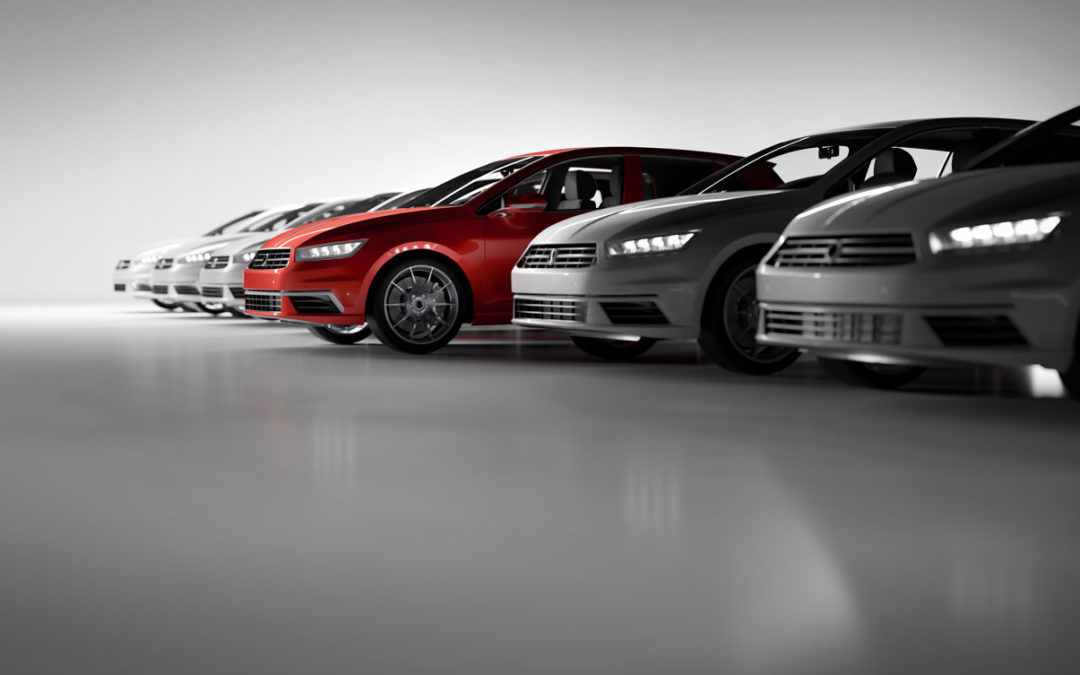
by Jane McCurry | Nov 26, 2019 | Electric Vehicles
The Energy Gang, a Green Tech Media (GTM) podcast, dives into energy, clean technology, and environmental issues. We’re very excited to welcome Katherine Hamilton, one of the show’s co-hosts, as our keynote speaker at our annual Renewable Energy Summit to take place on Thursday, January 16, 2020! Katherine is also the Chair of 38 North Solutions, a public policy firm focused on clean energy and innovation, which she co-founded.
While we wait for Katherine’s visit to Wisconsin in January, we’re listening to The Energy Gang Podcast. I was especially intrigued by the October 26 episode, “Who’s Trying to Re-Kill the Electric Car?” The title is a spoof on the film, Who Killed the Electric Car? which came out in 2006. The documentary is a reminder of previous attempts to make electric vehicles mainstream. In 1997, after a California air emissions mandate, General Motors launched the EV1, the first electric vehicle made for the mass market. After only 6 years on the market, the EV1 was recalled and the vehicles were destroyed.
This Energy Gang episode digs into the question: Are we in the midst of the same story at a grander scale?
Who (if anyone) is re-killing the electric car?
There is certainly momentum in the EV market that points to a long and prosperous life for today’s electric cars. Bloomberg New Energy Finance says 57% of passenger vehicles sales could be electric by 2040. EVs are already cost competitive, with a lower cost per mile to operate and very little maintenance.
With more and more electric vehicles, we demand less and less gasoline. This sets up an interesting dynamic between oil companies and electric utilities. While these industries have often agreed (or left each other alone) on big policy issues, they’re beginning to fight over the market to fuel our vehicles.
We’re just beginning to see how this conflict will play out. Transportation is a huge market – Wisconsin alone spends $8.4 billion per year (yes, that’s billion with “b”) to fuel our vehicles, all of which is sent out of the state, and much of it out of the country, to purchase liquid fossil fuels to run our vehicles.
It’s no surprise that oil and gas companies see electric vehicles as a threat. In fact, many of them are pivoting to include electric vehicle charging in their line of services. In Europe, gas companies own a lot of the public charging infrastructure and BP recently bought Greenlots, a charging station software provider.
What about our local gas station owners? The Energy Gang says they don’t seem to care that much, but they are considering installing EV chargers. Gas stations could somewhat easily switch from one fuel to another, and keep people buying items in their convenience store, where they make the bulk of their profits.
How to Make Sure EVs Survive This Time
Utilities stand to gain from a growing electric vehicle market, and they are catching on fast. As energy efficiency has made big gains, overall electricity consumption is growing more slowly than it has in the past. Electrifying vehicles and other appliances is a real growth opportunity for power companies. Five years ago, utilities weren’t proposing programs to promote electric vehicles except in California. Now, utilities in 25 states have plans to invest in public electric vehicle charging.
In those 25 states, at least 10 have oil-affiliated groups pushing back. In Wisconsin, we are working hard to get the facts out about electric vehicles and make sure consumers and decision-makers understand the benefits of this transition, and the downsides to our current, expensive transportation fuel:
- EVs are for everyone. EVs are already cheaper to own and operate, and the costs of the vehicles themselves are coming down fast.
- EVs are better for the environment and will continue to get cleaner as our grid gets cleaner. Internal combustion engines, on the other hand, only get dirtier over time.
- In our view, power companies, government, and private businesses should be working together to build the charging network needed to support these vehicles, just like we built roads when cars first came along.
We’re watching this story unfold in Wisconsin. The Wisconsin Public Service Commission opened a docket to investigate the electric vehicle market and explore the roles that utilities and regulators could take in this new market. Stakeholders are welcome to participate in this docket. So far, dozens of organizations and individuals have submitted comments ranging from supportive and excited to questioning or downright anti-electric vehicle.
Our hope is this docket will help to build clarity and momentum in the market. We have allies who also believe in this transition, and we will continue working together to make sure the electric vehicles of today survive.
Consumers are driving the transition
Electric vehicle adoption will be in an exciting transition and one that I’m grateful to take part in. I was 2 years old when the 1997 EV-1 came to market. Had it not been “killed,” maybe my first car would have been electric? We’ve come a long way since then. Now, consumers are driving the EV market and demanding high quality electric cars. The market is delivering and we should keep it thriving.
If you want to learn more about electric vehicles and clean energy, you should attend our Renewable Energy Summit on January 16, 2020 in Madison, Wisconsin! Keynote Speaker Katherine Hamilton will be discussing these issues and more. Our Presenting Sponsors are on the cutting edge of our clean energy future, with Invenergy developing large-scale solar and wind projects and Zerology establishing the nation’s first all-electric taxi fleet!

by Tyler Huebner | Nov 1, 2019 | Renewables, Solar, Utilities
Yesterday, Alliant Energy’s Wisconsin Power & Light utility company announced plans to add 1,000 megawatts of solar power by 2023 to provide more clean, renewable energy to their Wisconsin customers.
By our analysis, this commitment to solar power would equate to:
- About 2.7% of Wisconsin’s entire electricity consumption
- Enough electricity to provide the annual needs of about 250,000 Wisconsin residential electric customers
- An estimated $5,000,000 annually in land leases paid to landowners who would lease their land to the solar projects
- $4,000,000 annually provided across the local townships and county governments where the projects are located (if in Wisconsin), allocated through the state’s utility shared revenue formula
- Create about 1,600 jobs during construction
- Currently Wisconsin uses about 9,200,000 acres as farmland and has 34,700,000 total acres of land. The approximately 7,000 acres of solar would sit on just 0.076% of Wisconsin’s farmland and 0.020% of Wisconsin’s total land.
- With appropriate grassland and pollinator-friendly practices, the land under these solar arrays can provide numerous benefits by regenerating soil, supporting pollinators like bees and butterflies, and removing carbon from the air and burying it in the soil.
Tyler Huebner, RENEW Wisconsin’s Executive Director, issued the following statement: “This is another important announcement signifying solar power’s time has come in Wisconsin. The costs for solar power have declined about 80% in the past decade, making solar a cost-effective source of electricity for Wisconsin customers.”
Huebner continued: “In addition to utility-scale solar development, RENEW Wisconsin and our members know that solar on homes, buildings, and in our communities also provide tremendous benefits and we look forward to working with Alliant and other utilities to ensure distributed generation and other renewable resources have a fair and equal shot, and receive fair and equal treatment, at providing their benefits as the state continues to shift towards more homegrown, healthy, and smart renewable energy.”
Alliant also announced they will build the first of their “community solar” projects, a program previously approved by the Public Service Commission, in Fond du Lac.
For context, Wisconsin currently has approximately 130 megawatts of solar. In April 2019, approximately 500 megawatts of solar in Wisconsin were approved (450 megawatts were approved by the Public Service Commission and nearly 50 megawatts were approved by the Richland County Board).
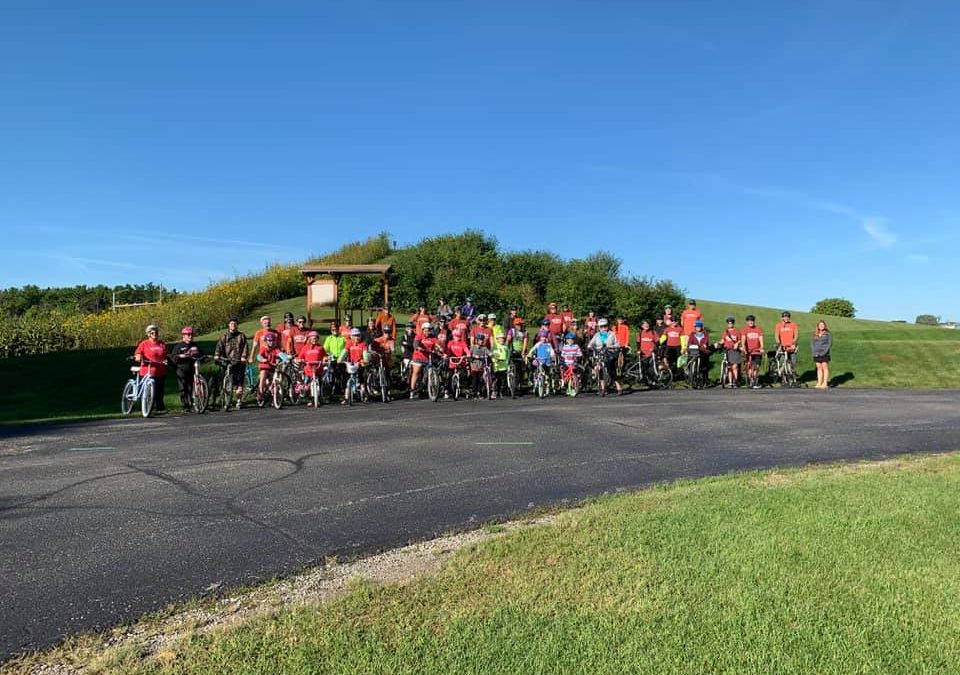
by Tyler Huebner | Sep 30, 2019 | Community, Electric Vehicles, Events, Geothermal, Hydroelectric, RENEW Wisconsin, Renewables, Solar, Wind
On Saturday, September 14th, our 7th Annual “Ride with RENEW” bike ride, held in the Fox Cities this year, was a huge success!
We started the morning at Prairie Hill Park in Grand Chute with 40 determined bike riders and 12 wonderful young ladies from the Girl Scouts of the Northwest Great Lakes! The State Representative for the area, Amanda Stuck, welcomed our riders by talking about the importance of energy, and how easy it has become to take advantage of clean energy sources.
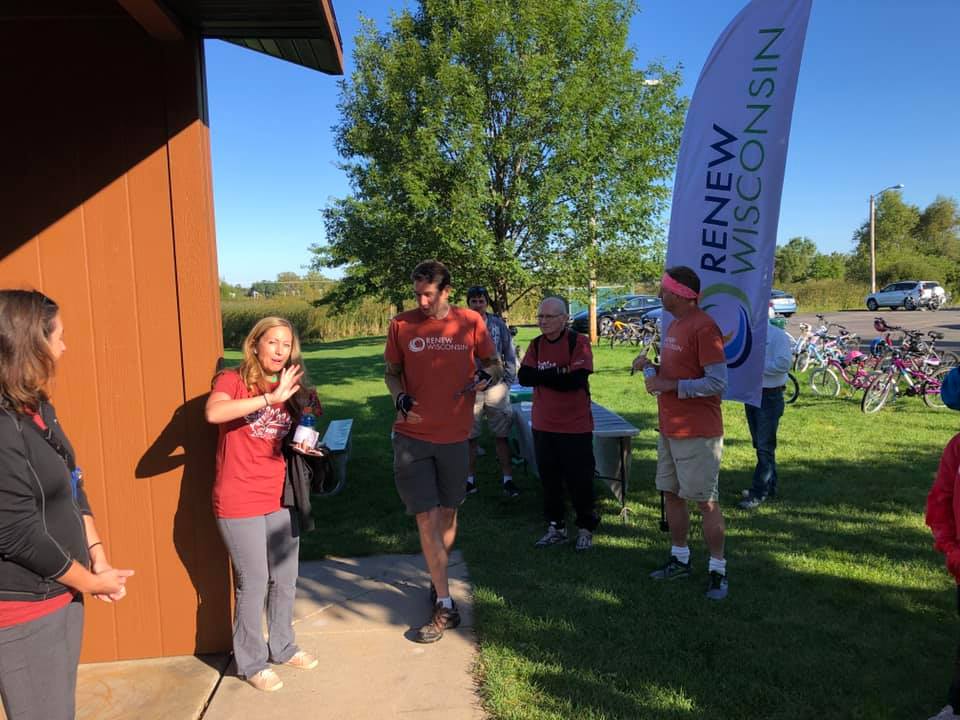
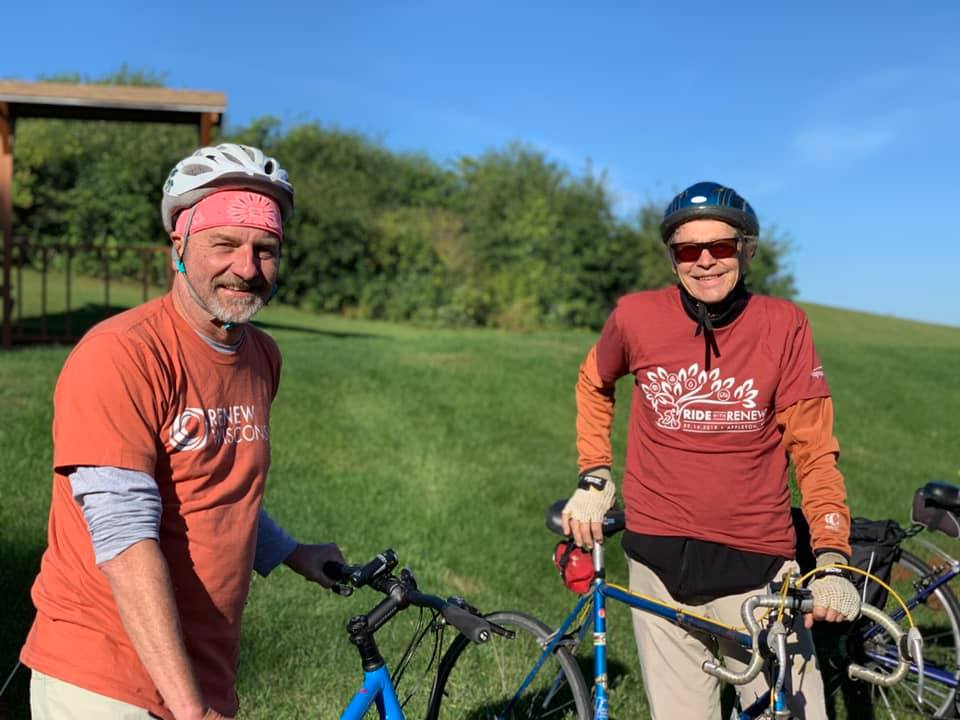
Our bike riders and Girl Scouts then set out for the Bubolz Nature Center where we explored their solar panels and microgrid, built and operated by Faith Technologies, who walked us through this one-of-a-kind facility in Wisconsin. The microgrid includes a lithium battery, a hydrogen fuel cell, and a generator, and the facility runs off the solar panels and renewable storage most of the time.
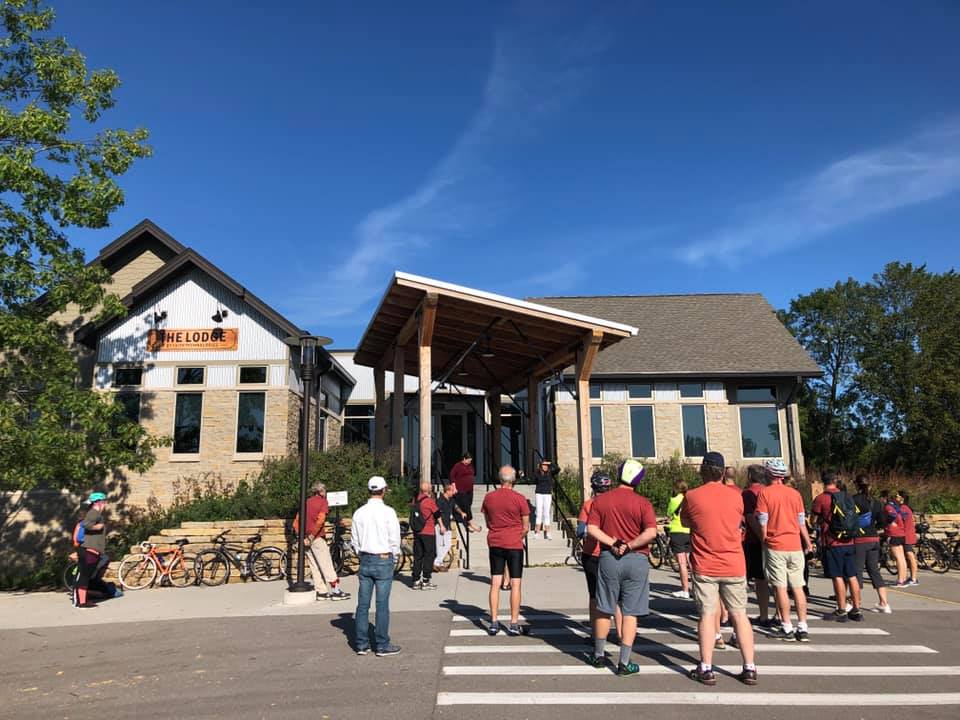
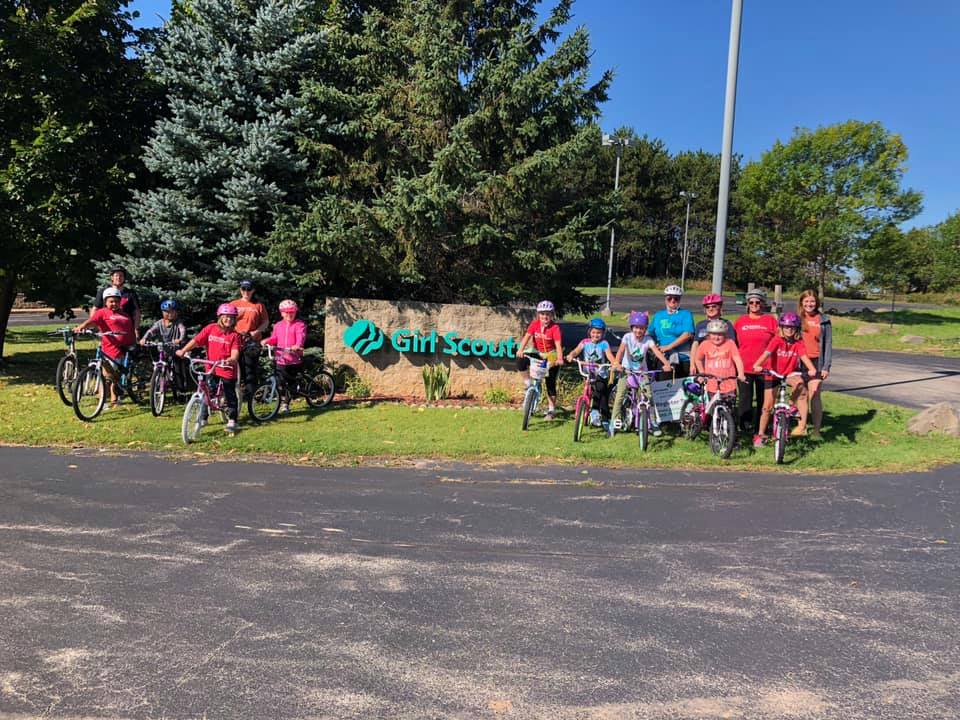
Next we biked 10 miles to Evergreen Credit Union which has become a regional leader in sustainability. With solar panels covering its roof, Roni Kasperek of Evergreen described the credit union’s migration to becoming a clean energy leader and how sustainability is a core value of the organization.
We turned Schildt Park into a clean energy mecca at lunch! Featuring pizza from Glass Nickel Pizza, we were fortunate to have the Ripon Lego League join us as they collected data from our bike riders to help them with their Lego challenge of designing a sustainable community! Our riders engaged in the Lego League’s survey, created to help the kids better understand bikers’ safety needs and how a city could better support bicycling. The Lego League kids did a great job helping to serve lunch and engage with our bikers!
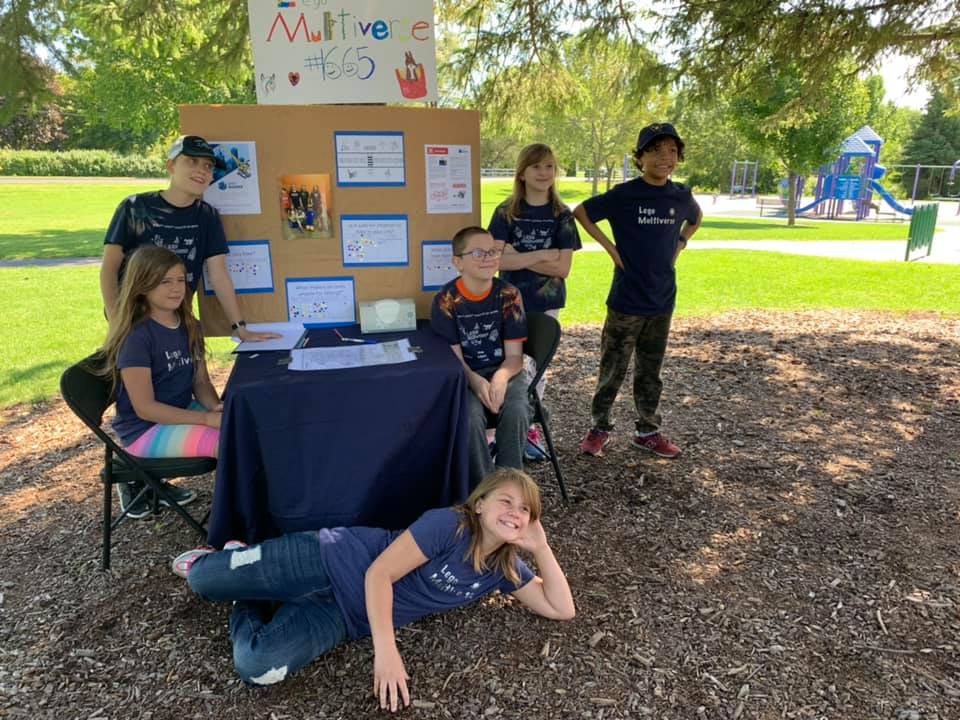
In addition, we had an electric vehicle exposition featuring 9 vehicles from 5 car brands that drive with electricity, instead of gasoline. This technology is advancing and many new types of affordable electric vehicles are coming out soon. We loved showing these cars off to our bike riders and a few members of the public, and the vehicle owners loved chatting about how much they enjoy driving electric.
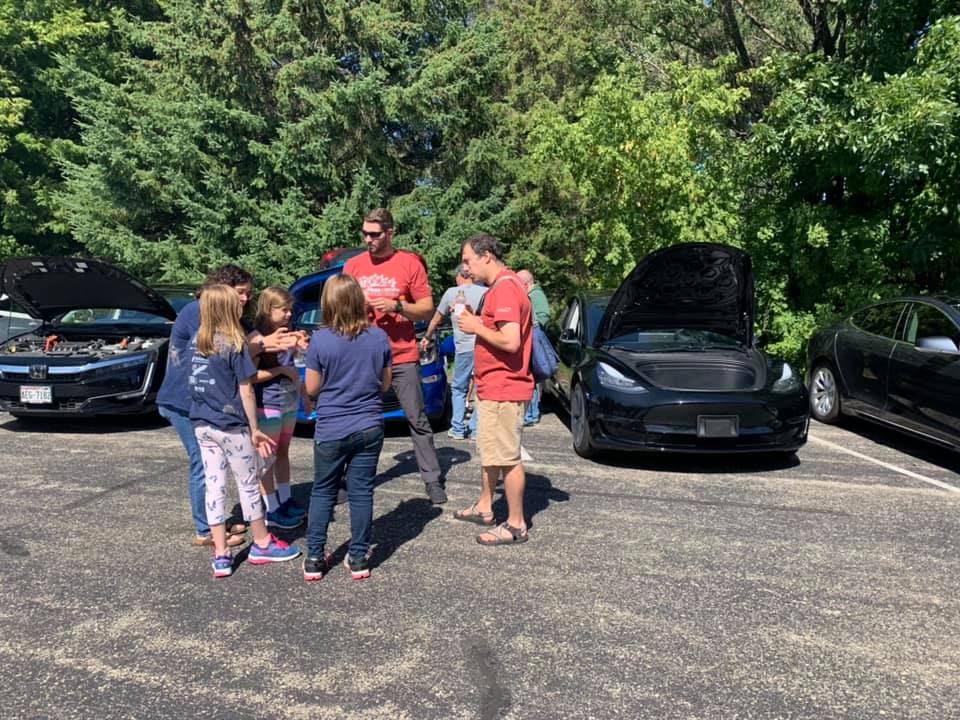
After lunch we saw small wind turbines at Essity (formerly SCA Tissue) right along the bike path. These 4 turbines were designed and installed by a former Wisconsin company called Renewegy (which is unfortunately no longer in business). Next we headed to Heckrodt Wetland Reserve in Menasha where we learned about their tremendous efforts to preserve this part of the state and how solar power is a sustainable part of their growth.
We next saw an innovative solar carport at the Petit and Dommershausen law offices in downtown Menasha, where were treated to a much-needed snack. Then we biked to RiverHeath, which is a new development in Appleton right along the Fox River. Mike Barnett of HGA described an innovative use of geothermal energy, designed by HGA and installed by G.O. Loop, that uses the temperature of the water to provide heating and cooling to the new buildings in the RiverHeath complex.
Last, but certainly not least, we biked to the first power plant in Wisconsin that delivered electricity to a customer. We were greeted by “Thomas Edison,” a generous measure provided by the Appleton Historical Society, who helped explain the origins of the Vulcan Street Hydropower Plant which was put into service in 1882 and provided electricity for lights at paper manufacturing plants as well as one home.
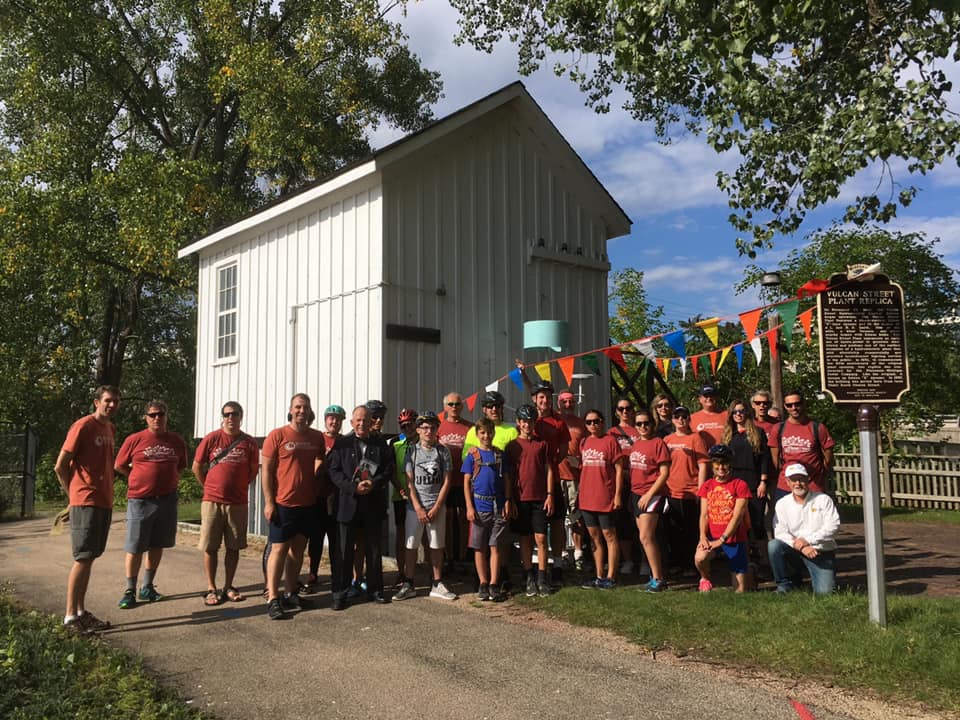
The actual Vulcan plant burned down in 1889. The Appleton Historical Society, as well as Ford Motor Company, contributed many hours and, in Ford’s case, equipment, to allow this replica of the original hydropower plant in Wisconsin to stand and to give visitors like us the opportunity to learn about Wisconsin’s energy history and see it in action.
Finally, we arrived back at Prairie Hill Park, where we enjoyed beer from Central Waters based in Amherst and celebrated a great event with our riders! The weather was outstanding, and we can’t wait to plan next year’s Ride with RENEW.
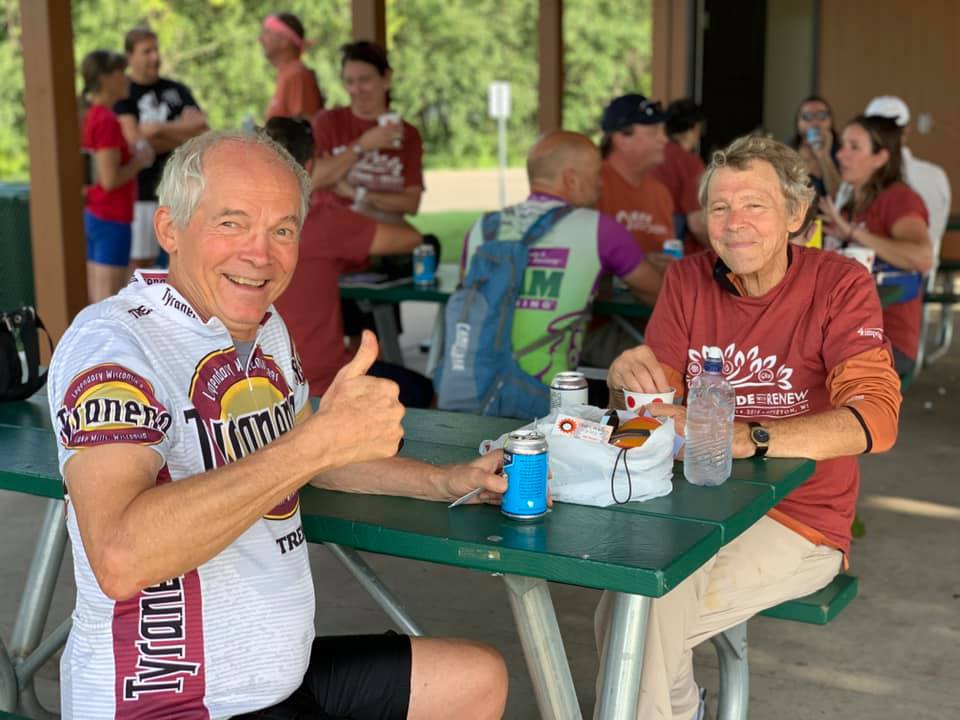
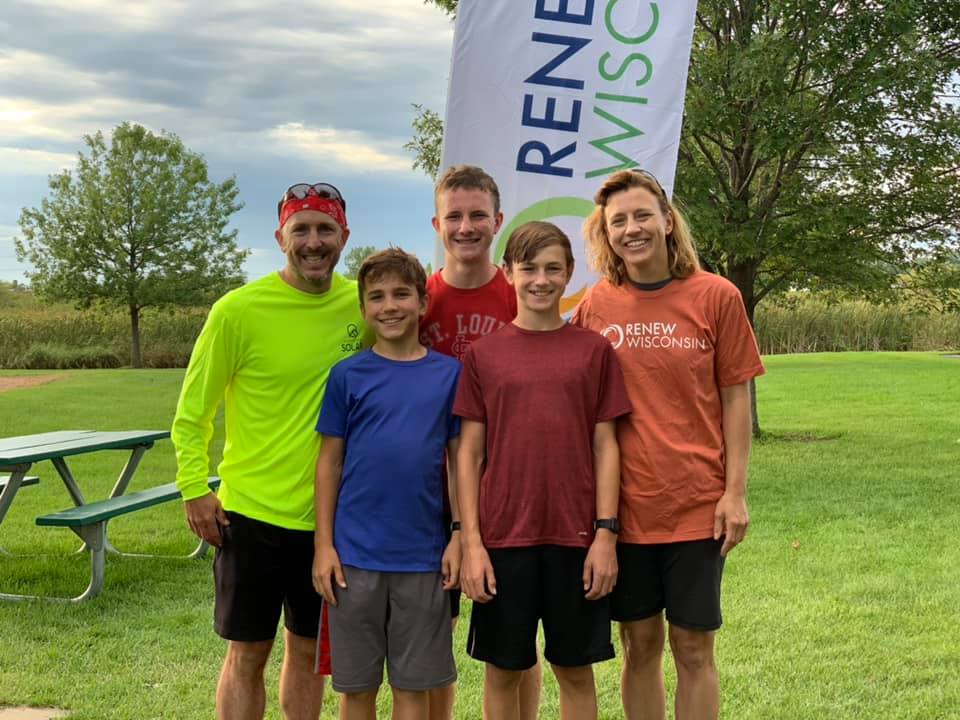
Four of RENEW staff members joined Board member Jim Funk of Energize LLC as he showed off one of Wisconsin’s earliest examples of “bi-facial” solar panels – panels that can receive light from both sides of the panel to create electricity. This installation at a carport has served as a beautiful visual example of solar energy in the Fox Cities since 2010. For example, check out the very cool design when our staff member Jim Boullion’s car was parked underneath the panels.
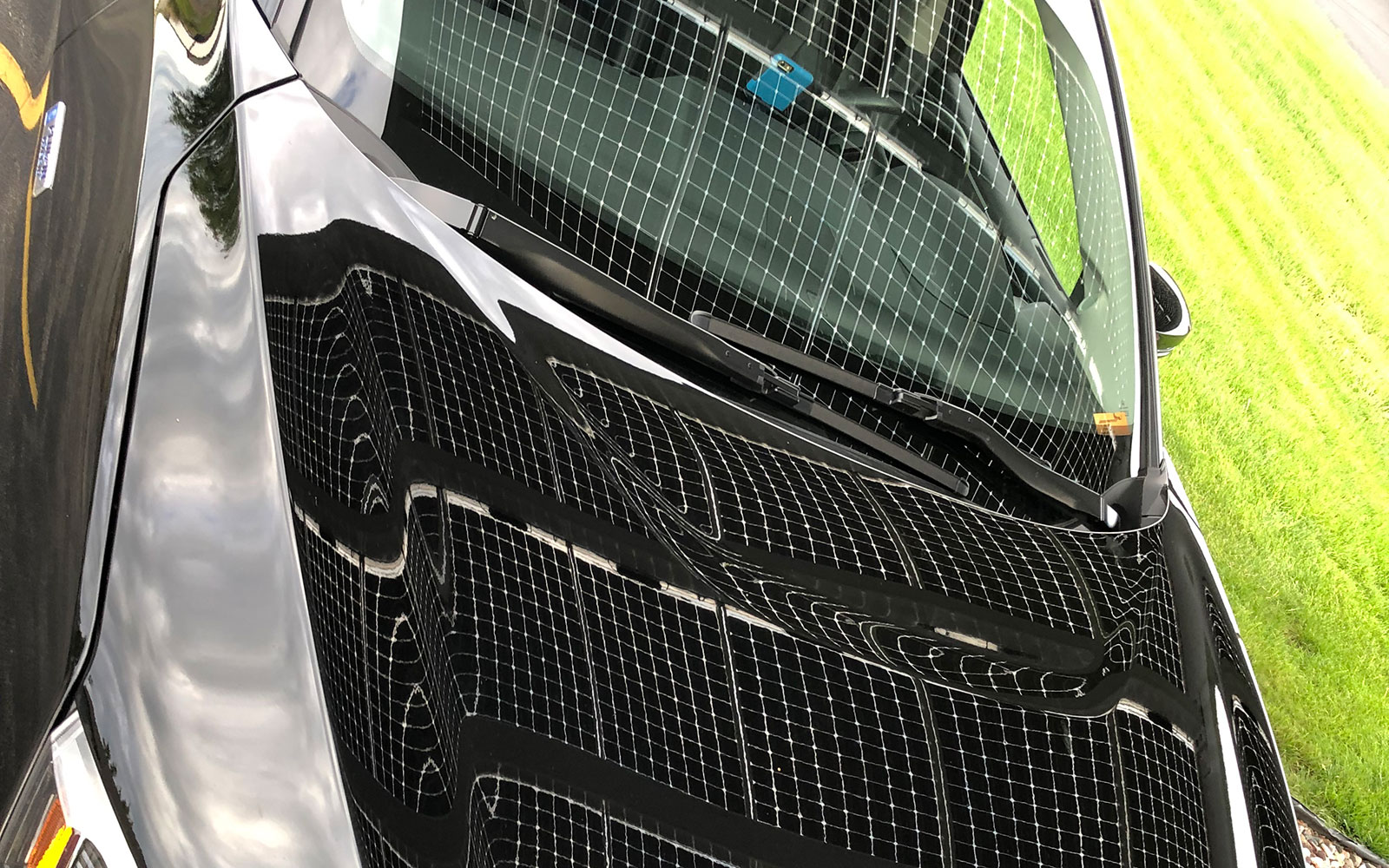
Check out our Facebook photo album to see more images of the ride!
Thank you again to all of our sponsors, shown below, all the bike riders, the Girl Scouts, Lego League, and everyone who donated to support our riders and helped us raise over $17,000 to continue our education, advocacy, and collaboration to advance renewable energy in Wisconsin!
2019 RIDE WITH RENEW SPONSORS
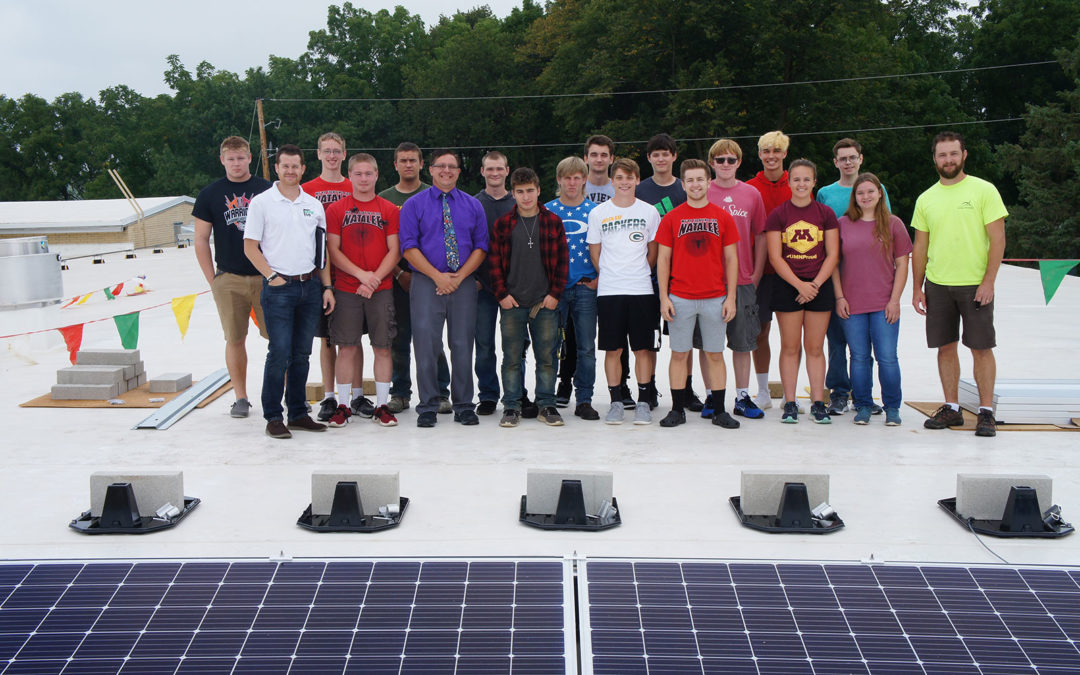
by Sam Dunaiski | Sep 26, 2019 | Community, Events, Programs, RENEW Wisconsin, Renewables, Solar, Solar for Good
Construction of Juda School District’s new solar array began on Tuesday, September 17th and Juda High School students got a first-hand look at the solar installation process. Ryan Harkins of Synergy Renewables, designed the 4-kilowatt solar array that will help the school offset its electricity consumption and reduce its utility bills.
Sixteen students, mostly seniors from Juda’s Calculus and Engineering classes participated in the installation process.
“Helping put solar panels on our school really shows what our Engineering class can accomplish,” said Juda student Tristan Geisking.
Harkins showed the students how to install the panels’ racking and connection devices, and the students also learned how solar energy is produced.
“Developing a solar project from the planning stages to the installation is an experience the students will remember for years to come,” said Harkins. “The students did a fantastic job.”
In 2012, the Juda School District set a goal of generating 10% of their electricity from renewable energy. The district had 36 solar panels installed in 2014 to offset its electric use. The new solar installation adds 12 more panels to the school’s rooftop and the two installations combined offset nearly 10% of the school’s electricity.
To help with costs, Juda received grants from RENEW Wisconsin’s Solar for Good program and the Public Service Commission’s Office of Energy Innovation. These grants helped fund the solar array, and a host of other energy efficiency measures at the school including building envelope improvements, HVAC optimization, and 100% LED lighting.
“Initially, the proposed payback to the school district would take 6 years. Now, thanks to the Energy Innovation Grant, the school is already realizing the savings,” stated Mario Millonzi, President of Upper 90 Energy and contractor on the project.
Juda is now saving over $30,000 per year in utility costs, and over $6,000 in yearly maintenance costs. The school, however, sees the cost-savings as only one part of the project’s benefits.
“At Juda, we issue the challenge to the students to make the school, the community, and the world better,” said Juda Math and Engineering Instructor, Scott Anderson. “This project accomplishes all three.”
Students at Juda were key to the success of the projects. In addition to helping with the installation, they helped write grants and worked with Upper 90 on the energy saving details.
“Creating students who are aware of their role as stewards of our world may be the single most important thing I teach,” added Anderson. “Once they get started, it’s great to see what they can accomplish.”
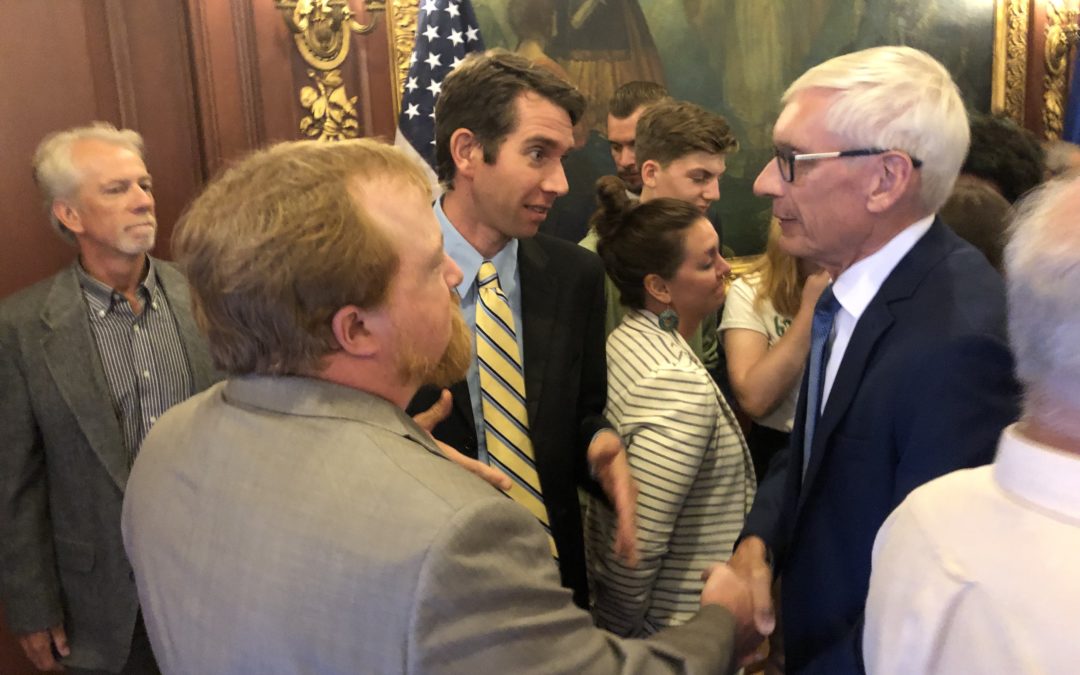
by Michael Vickerman | Sep 23, 2019 | Advocacy, Biogas, Community, Jobs, Public Service Commission, RENEW Wisconsin, Renewables, Solar, Solar for Good, Utilities, Wind
Last month, Governor Tony Evers delivered an ambitious clean energy vision for Wisconsin, which the editors of the Wisconsin State Journal aptly summarized: “Goal: Carbon-free by 2050.”
Executive Order #38 creates the state’s Office of Sustainability and Clean Energy, and directs the new office to “achieve a goal of ensuring all electricity consumed within the State of Wisconsin is 100 percent carbon-free by 2050.” This office will take the lead in planning and coordinating the Evers Administration’s efforts to greatly increase its own reliance on carbon-free electricity, and develop strategies for expanding clean energy throughout the state. The administration envisions accomplishing these goals through a partnership with other state agencies and state electric utilities.
To demonstrate that this initiative will very much be a team effort, Governor Evers was joined by Lt. Gov. Mandela Barnes, Public Service Commission Chairperson Becky Cameron Valcq and Department of Natural Resources Secretary-designee Preston Cole.
With this order, clean energy becomes again a policy priority, advanced to not only bolster the state’s economy and protect its natural resources, but also promote the health and well-being of its citizenry. What’s also notable about Evers’ initiative is the degree to which it is grounded in climate science. The order frames climate change as an escalating environmental problem that is already doing harm to the state on several fronts. An effective response from state government, therefore, demands aggressive and sustained action. Moving to carbon-free electricity by 2050 certainly qualifies on that score.
Now, an executive order is not the same thing as a law. Executive orders carry no legal weight, which explains why they are narrowly drawn to address matters that are totally within a governor’s control, such as agency priorities. Moreover, they are not binding on future governors and their administrations. That said, we are hopeful that the clean energy actions taken today by this Administration will cultivate, over time, buy-in from state legislators, and that from this order will emerge comprehensive, forward-looking policies that will put Wisconsin on track to becoming a renewable energy leader.
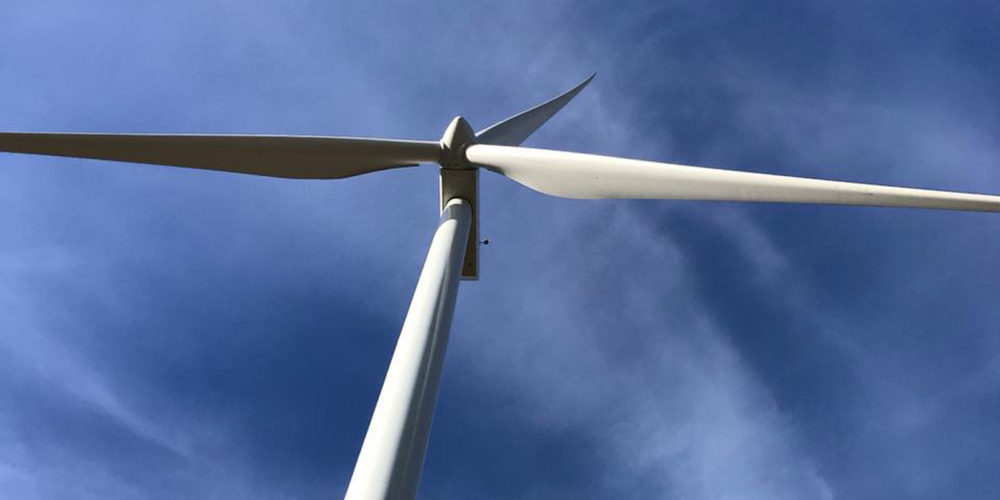
Wisconsin utility commitments set the stage
As audacious as it may appear, Evers’ clean energy goal is actually in line with recent utility commitments to decarbonizing their generation mix. Whether set at 80% or at 100% by 2050, the level of carbon reductions that Wisconsin electric providers have publicly embraced are ambitious, when compared with current levels. In 2018, the percentage of renewable and nuclear generation combined, relative to total sales, was approximately 25%. We’ll probably need to quadruple today’s volume of carbon-free electricity, depending on how much energy efficiency reduces our consumption compared with how much transportation and other direct uses of fossil fuels become electrified by 2050. No matter what happens, this transition will require a concerted and sustained push on the part of every electric provider.
Fortunately for the state’s utilities, there has never been a more propitious time to invest in carbon-free electricity, especially from wind and solar plants, than right now. The capital costs of new wind and solar farms are at their all-time lows, and their operating costs are a fraction of what it costs to buy the fuel for coal and natural gas plants operating today.
The signs that utilities are seizing this opportunity are multiplying. As they move to permanently shutter older and less efficient coal- and natural gas-fired generators, Wisconsin power providers are either busy purchasing more renewable electricity from new plants or building more solar and wind farms for themselves.
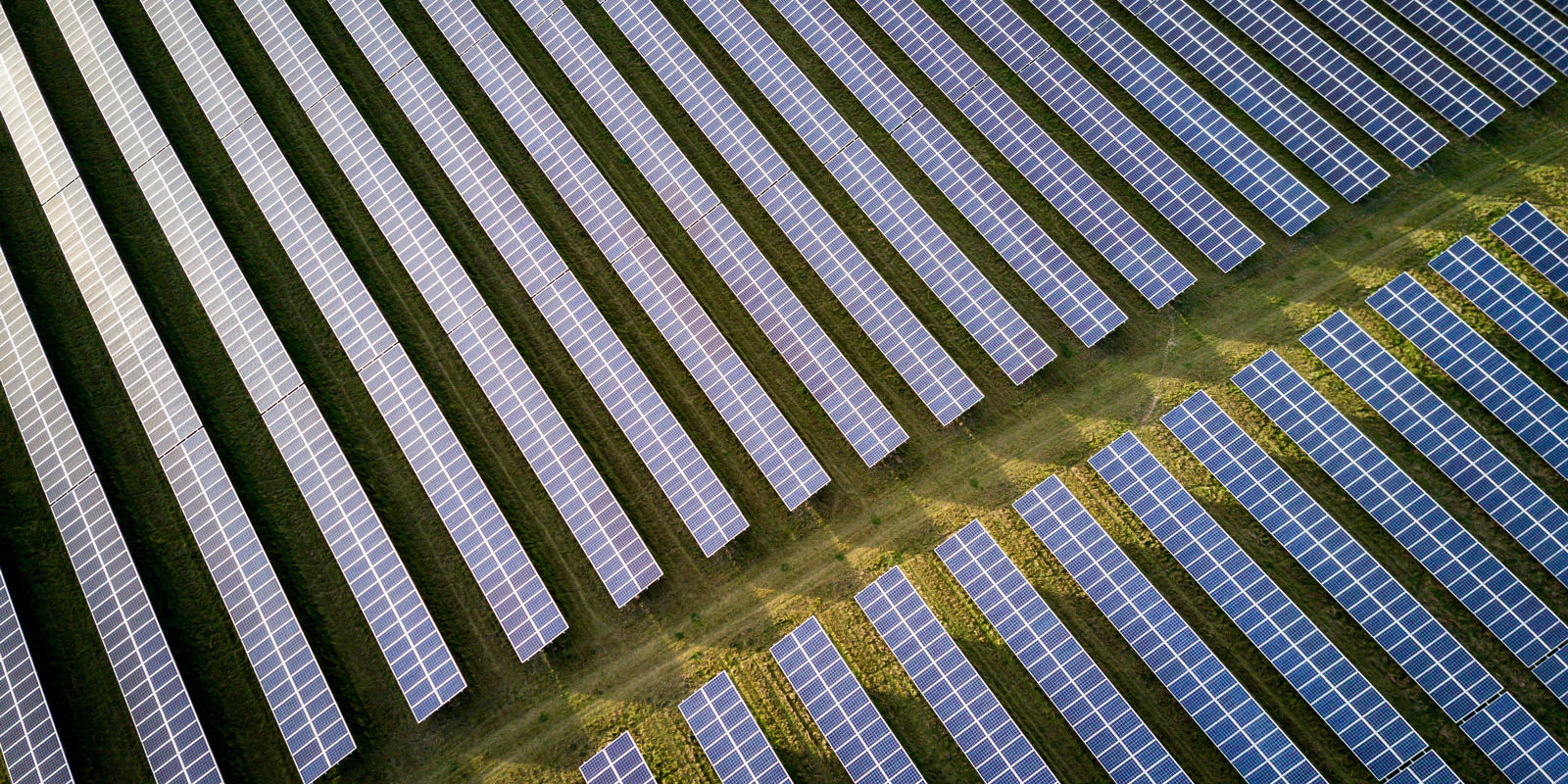
Powering up Wisconsin agriculture
In the week following Governor Evers’ Executive Order, ground was broken for the Two Creeks plant, one of the two large solar plants owned by Madison Gas and Electric and WEC Energy. Located a mile from the Point Beach Nuclear Power Plant, this 800-acre solar farm will, by itself, more than double existing solar capacity when completed next year, from 120 megawatts (MW, measured in AC or alternating current) to 270 MW.
That total will more than double again when the 300 MW Badger Hollow solar farm, located in Iowa County, becomes fully operational at the end of 2021. And other Wisconsin utilities, WPPI Energy and Dairyland Power, have signed power purchase agreements from 249 additional megawatts of solar from two projects, both of which are now seeking approval from the Public Service Commission and could also be built in 2020-2021.
Solar farms deliver far more value to the public and the planet than simply megawatt-hours of electricity produced and tons of carbon dioxide avoided. There are also the jobs that go into the construction of these arrays, the revenues that allow farmers to keep farming their land, revenue payments to local governments that host the projects, and the rich habitat for pollinators and wildlife that is created as the soil recharges. Harnessing solar energy for productive purposes has been and will continue to be integral to Wisconsin agriculture.
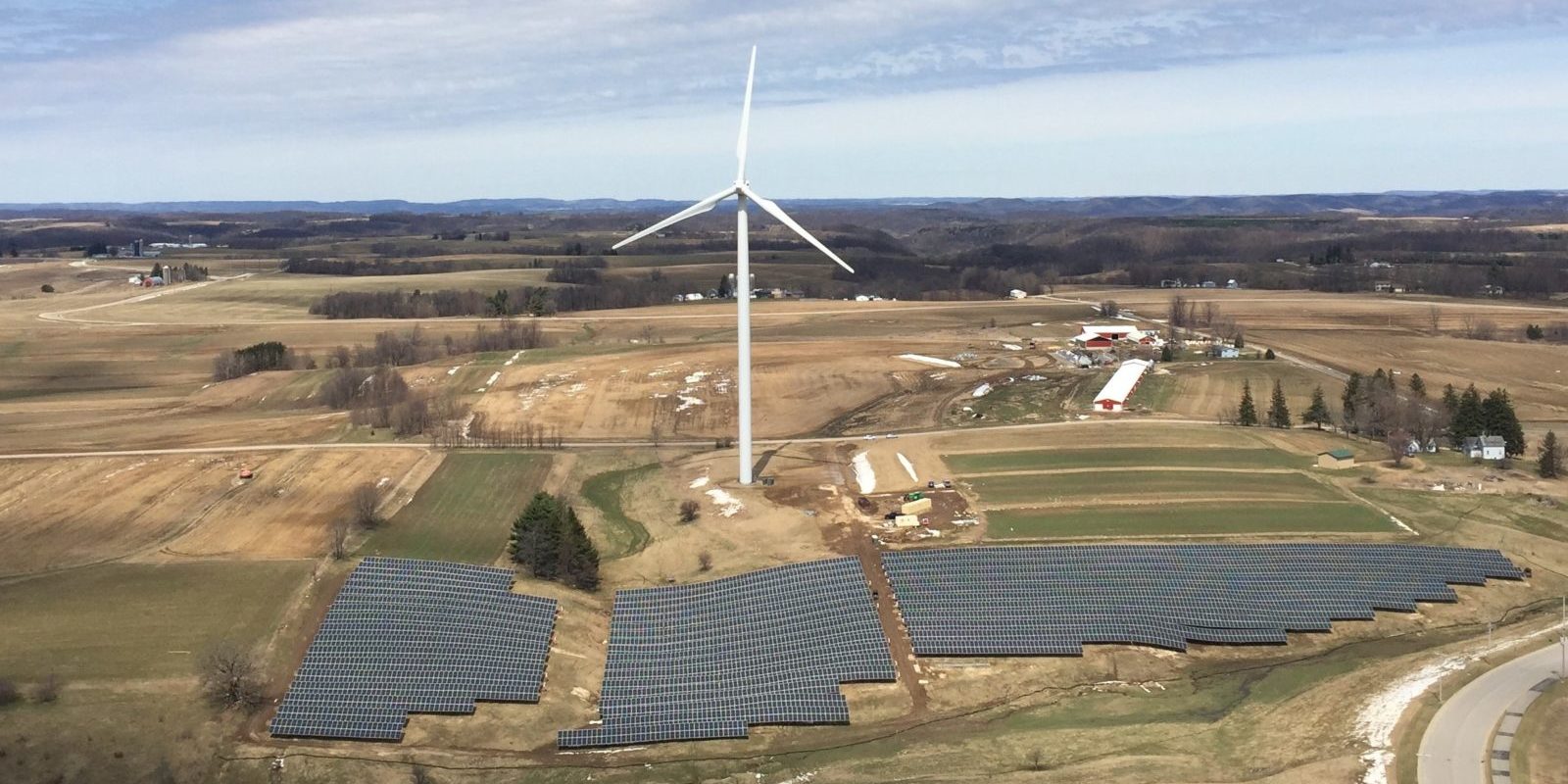
Meet the 100% renewable energy club
To put an exclamation mark on the last point, one of the most productive actors on the American agriculture scene—LaFarge-based Organic Valley Cooperative—financed the construction of two smaller solar farms in western Wisconsin. These two arrays—one in Arcadia and the other in Cashton—were energized last month and are now sending power into the grid.
That new increment of renewable electricity, when added to Organic Valley’s previous investments in solar and wind power, will enable the cooperative to offset 100% of its electricity use from zero-carbon, renewable sources. Organic Valley is the largest U.S. food brand to have accomplished that feat.
Organic Valley is the second Wisconsin enterprise to achieve a 100% renewable electricity goal. The first was La Crosse-based Gundersen Health System, which achieved that milestone five years ago through a combination of intensive efficiency measures and small-scale renewable power projects, usually off-site. In addition to reducing its energy overhead and passing the savings along to the people it serves, Gundersen wanted also to lead by example, demonstrating to the health care industry that sustainable energy is “healthy, socially responsible and economically beneficial.”
It is not unrealistic to expect that, in the next 10 years, hundreds of businesses and local governments will manage to achieve the same feat pioneered by Gundersen and Organic Valley.
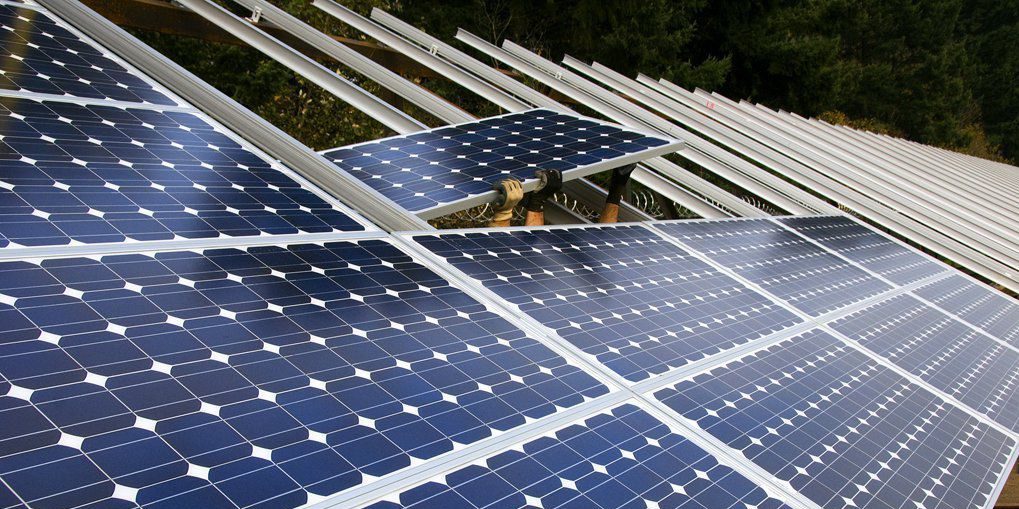
Connecting customers to solar power
When Gundersen pursued energy efficiency to reduce its energy overhead and generate carbon-free electricity as offsets, it had to settle on a path that effectively bypassed the electric providers serving their facilities. But some utilities are no longer content to stand on the sidelines while their customers sponsor new clean energy generation by their own initiative. Newer services such as shared solar and renewable energy sleeve tariffs enable self-selecting customers and utilities to partner on new clean power projects.
For example, Xcel Energy’s Solar*Connect Community program has been particularly successful in eliciting customer subscriptions to purchase electricity produced from new solar arrays in western Wisconsin. While there is an up-front cost to this service, the price of solar power is fixed, and may over time become less expensive than standard electricity, depending on the size and frequency of future rate increases.
It’s worth noting that this is not a required service in Wisconsin, and therefore many residents and businesses here do not have access to a utility-provided shared solar service. Expanding shared solar throughout the state would allow more residents and businesses to benefit from the clean energy evolution.
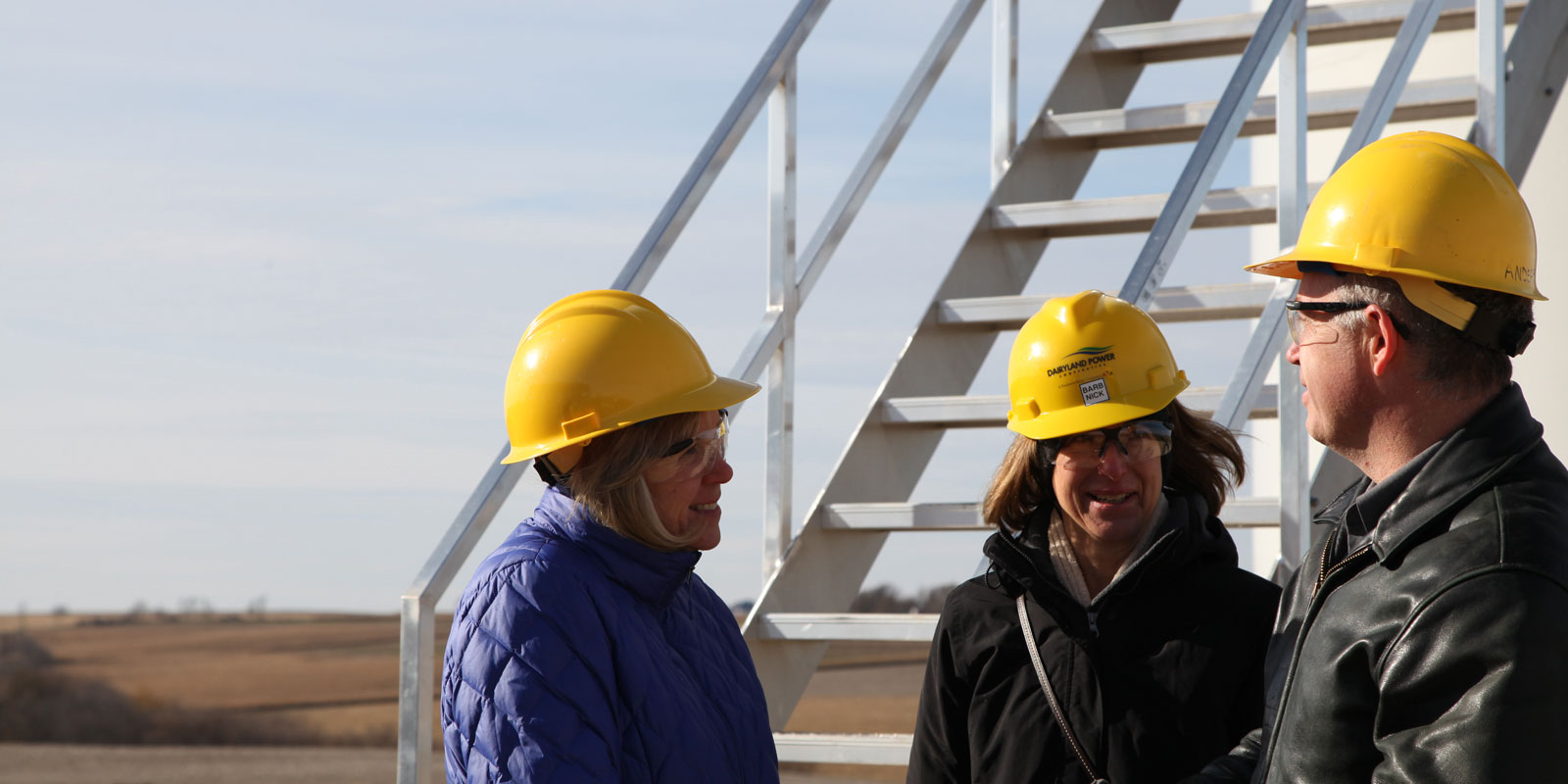
Wind power returning for duty
Back in 2006, when Wisconsin’s renewable energy standard was raised to its current level, wind power was poised to become the workhorse of the renewable electricity world. It did become so in several states, among them Texas and Iowa. But while wind power supplies 16% of Texas’ electricity and nearly 40% of Iowa’s power, Wisconsin’s rancorous siting and permitting climate has severely hobbled wind’s growth here since 2011. Right now, wind accounts for about 2.5% of electricity produced in the Badger State. Wisconsin utilities own, or buy power from, wind farms in other states which, if included, brings the total amount of wind being credited to Wisconsin customers to about 7% of the state’s electricity consumption.
Wind development activity is beginning to rebound, however, especially in the southwestern part of the state. But it will need to spread beyond the small pockets of the state where the current population of wind farms now operate. With capital costs going down and turbine productivity going up, wind development can occur cost-effectively over a wider swath of Wisconsin than what was considered suitable 10 years ago.
And why not include Lake Michigan among the areas that can host tomorrow’s wind farms? Engineering advances and improvements in foundation design make offshore wind power in waters deeper than 100 feet a feasible option. The ripple effects through the eastern Wisconsin economy would be substantial, especially for companies that manufacture cranes and marine construction vessels. Offshore wind can happen here with the right leadership.
But while the picture for wind power going forward remains uncertain, it’s all systems go for solar power. What is now an affordable resource for power providers is also an equally attractive option for electricity customers of all sizes, classes, and groupings, whether the solar array is dedicated to one home or business or to a school district or local government. Partnerships forming around solar energy are multiplying across the state and much of the nation.
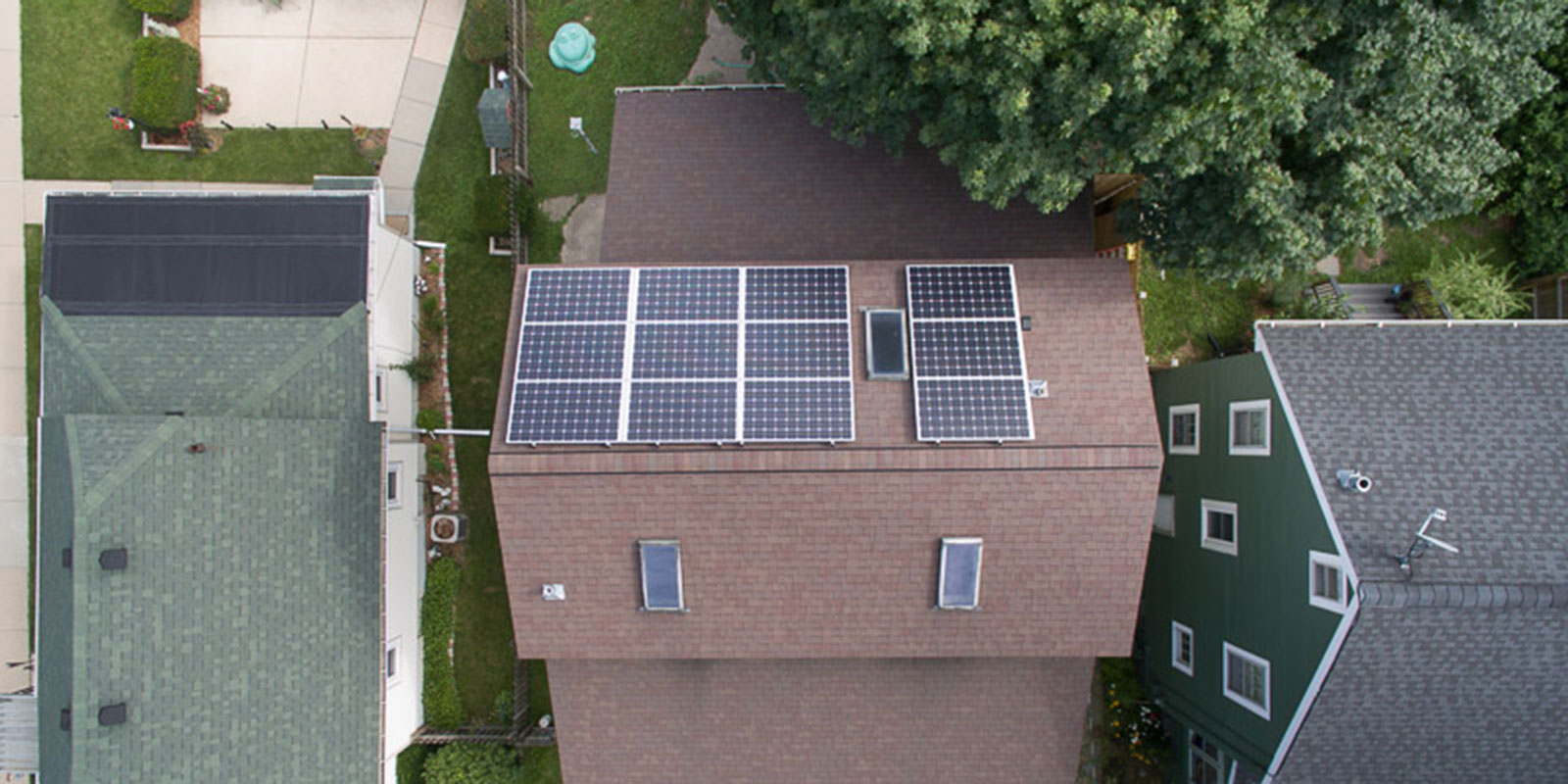
Customer-sited generation growing, but needs to be unleashed
From 2013 to 2018, customer-sited generation was the primary bright spot in Wisconsin’s renewable energy landscape. Customer-sited solar grew from 17 megawatts in 2013 to about 80 megawatts by year-end 2018, and the market continues to grow as the cost of installing solar power has declined. Initiatives like our Solar for Good and Faith & Solar programs have made solar power an affordable option for more than 40 nonprofits across Wisconsin, with 30 more working on projects this year.
But we know there are speed bumps, and it’s past time to fix them. The 20 kilowatt net metering threshold set by most of Wisconsin’s utilities often and unnecessarily limits the ability of customers, especially larger businesses and nonprofits, to supply themselves with renewable power. Generators that exceed the net metering threshold are penalized for exporting power to the grid.
This situation has especially been hard on Wisconsin’s biogas generators. After their initial contracts expire, biogas generators face the prospect of a 60% reduction in revenue flow. Many have already stopped generating electricity as a result, and are now flaring biogas instead.
With Wisconsin utilities now clearly moving towards building renewable power and retiring coal plants, it’s time to equalize the treatment of customer-sited renewable generators relative to large solar farms. If utilities need more daytime power capacity, they should credit distributed generators like solar and biodigesters at the same level that is accorded to their own renewable power plants. Our net metering rules need to be strengthened to capture more of the great potential and benefits that we know distributed generation brings to Wisconsin.
It’s also time to enable financing of clean energy systems, such as third-party leases and power purchase agreements, so that more low- and moderate-income Wisconsinites can take advantage of “pay as you go” solar energy financing options which are commonly available in more than half of the United States.
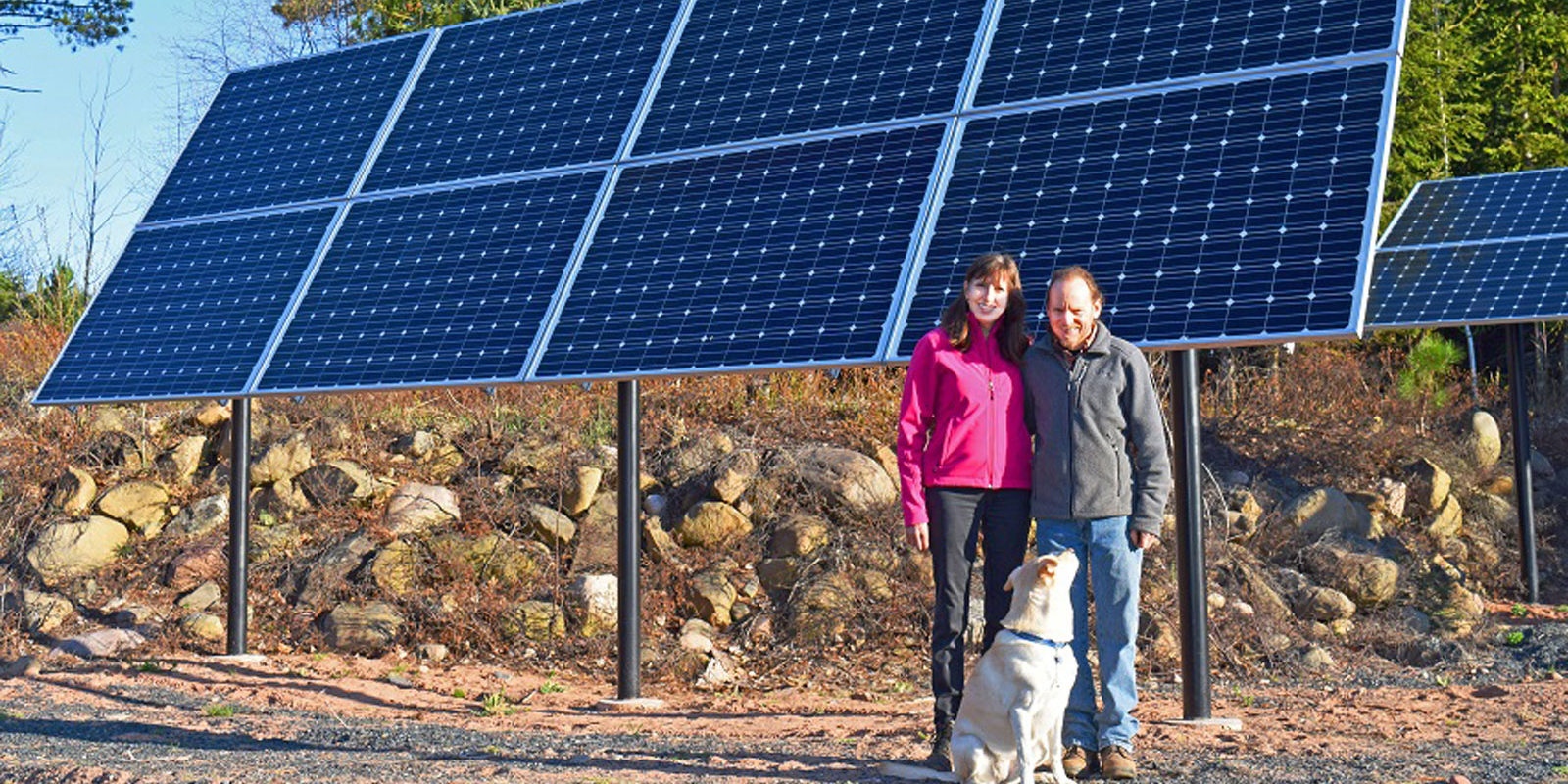
The value of partnerships
A particularly powerful example of solar partnerships can be found in the Ashland-Washburn-Bayfield area. Operating on a shoestring over its four-year history, Cheq Bay Renewables, an all-volunteer organization, has designed and developed several community-scale projects notable for their affordability and popularity. One of these is a solar group buy program, now in its second year, that has yielded nearly one megawatt of new capacity serving area homes, farms, and small businesses.
Supported initially by a $10,000 Solar in Your Community Challenge grant from U.S. Department of Energy (USDOE), the organization’s latest venture is set to deliver more than a dozen solar systems to schools, county-administered housing, wastewater treatment plants, and other public facilities in the Washburn-Bayfield area. Cheq Bay’s next project after that will put solar systems on three tribal buildings serving the Bad River Band of Lake Superior Tribe of Chippewa Indians. Half the funding for Bad River’s solar systems will come from U.S. DOE.
Through a combination of creativity, resourcefulness, and hard work, Cheq Bay Renewables has been the catalyst for the renewable energy transformation occurring in northern Wisconsin. Though the progress it has made thus far is nothing short of amazing, it wouldn’t be happening without all the partnerships that Cheq Bay has meticulously cultivated with local governments, federal and state agencies, electric providers, and sustainable energy professionals.
Partnerships like these are essential for getting the job done. And Executive Order 38 sets the stage for a new round of partnerships and collaboration to achieve the bold vision for Wisconsin’s clean energy future that Governor Evers and his Administration now embrace. From what’s happening on the ground, we know many initiatives are delivering results today, and these bright spots will be the foundation to creating a statewide clean energy success story.



















